Historical Development of Tour and Travel Industry
VerifiedAdded on 2020/10/22
|21
|4499
|142
AI Summary
The assignment provided explores the historical development of the tour and travel industry, discussing its unique progression over time. It highlights different periods of development, including technical advancements, and emphasizes the importance of government bodies in shaping the industry's trajectory.
Contribute Materials
Your contribution can guide someone’s learning journey. Share your
documents today.
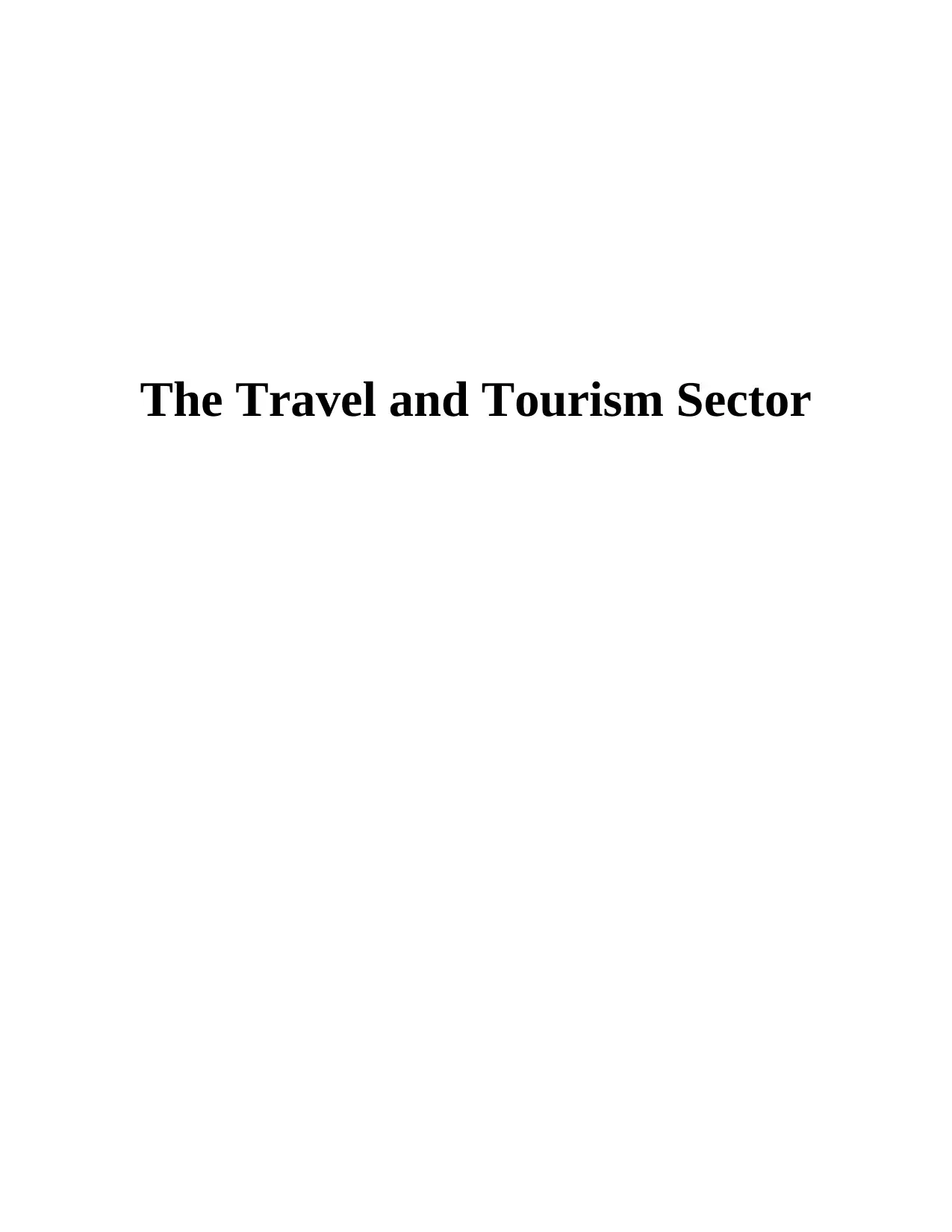
The Travel and Tourism Sector
Secure Best Marks with AI Grader
Need help grading? Try our AI Grader for instant feedback on your assignments.
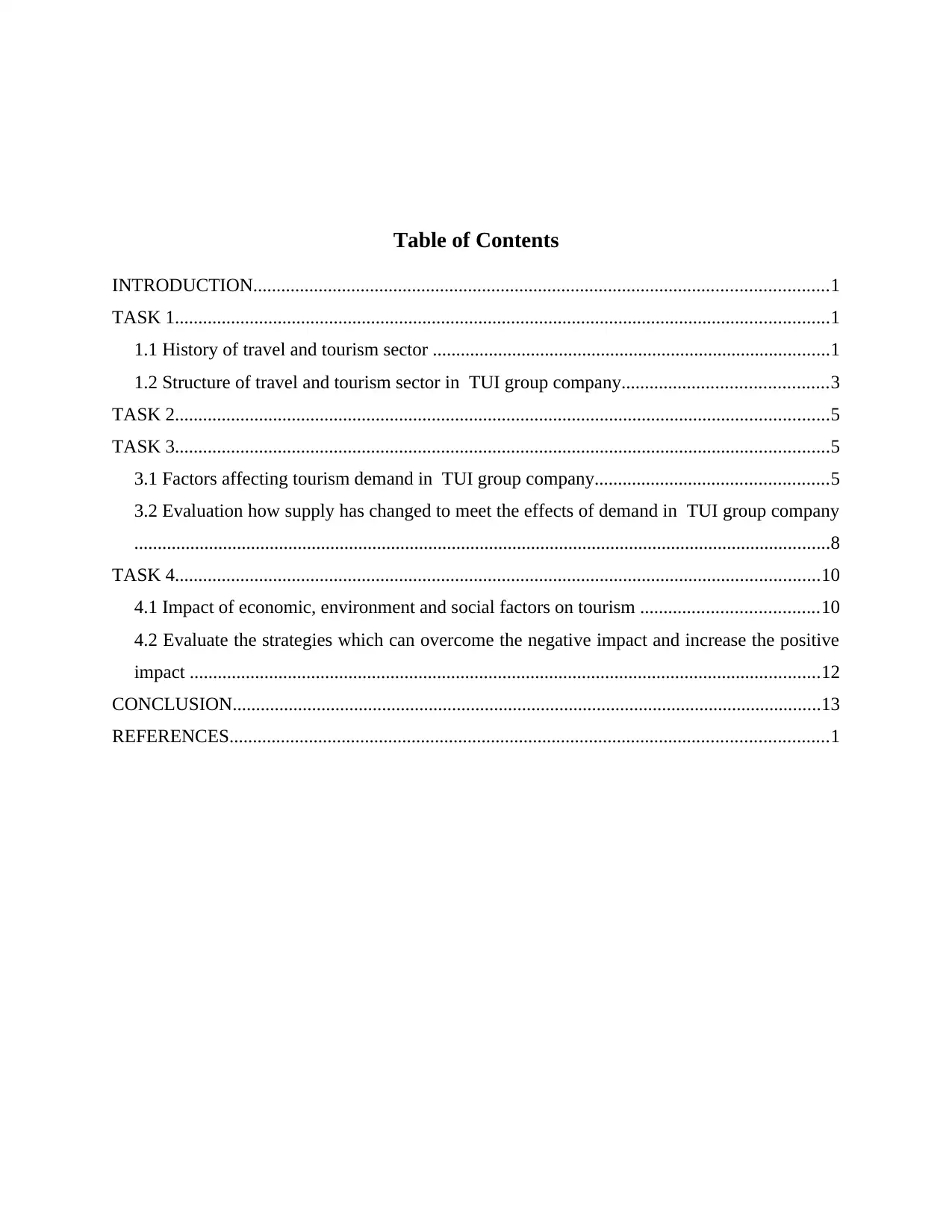
Table of Contents
INTRODUCTION...........................................................................................................................1
TASK 1............................................................................................................................................1
1.1 History of travel and tourism sector .....................................................................................1
1.2 Structure of travel and tourism sector in TUI group company............................................3
TASK 2............................................................................................................................................5
TASK 3............................................................................................................................................5
3.1 Factors affecting tourism demand in TUI group company..................................................5
3.2 Evaluation how supply has changed to meet the effects of demand in TUI group company
.....................................................................................................................................................8
TASK 4..........................................................................................................................................10
4.1 Impact of economic, environment and social factors on tourism ......................................10
4.2 Evaluate the strategies which can overcome the negative impact and increase the positive
impact .......................................................................................................................................12
CONCLUSION..............................................................................................................................13
REFERENCES................................................................................................................................1
INTRODUCTION...........................................................................................................................1
TASK 1............................................................................................................................................1
1.1 History of travel and tourism sector .....................................................................................1
1.2 Structure of travel and tourism sector in TUI group company............................................3
TASK 2............................................................................................................................................5
TASK 3............................................................................................................................................5
3.1 Factors affecting tourism demand in TUI group company..................................................5
3.2 Evaluation how supply has changed to meet the effects of demand in TUI group company
.....................................................................................................................................................8
TASK 4..........................................................................................................................................10
4.1 Impact of economic, environment and social factors on tourism ......................................10
4.2 Evaluate the strategies which can overcome the negative impact and increase the positive
impact .......................................................................................................................................12
CONCLUSION..............................................................................................................................13
REFERENCES................................................................................................................................1
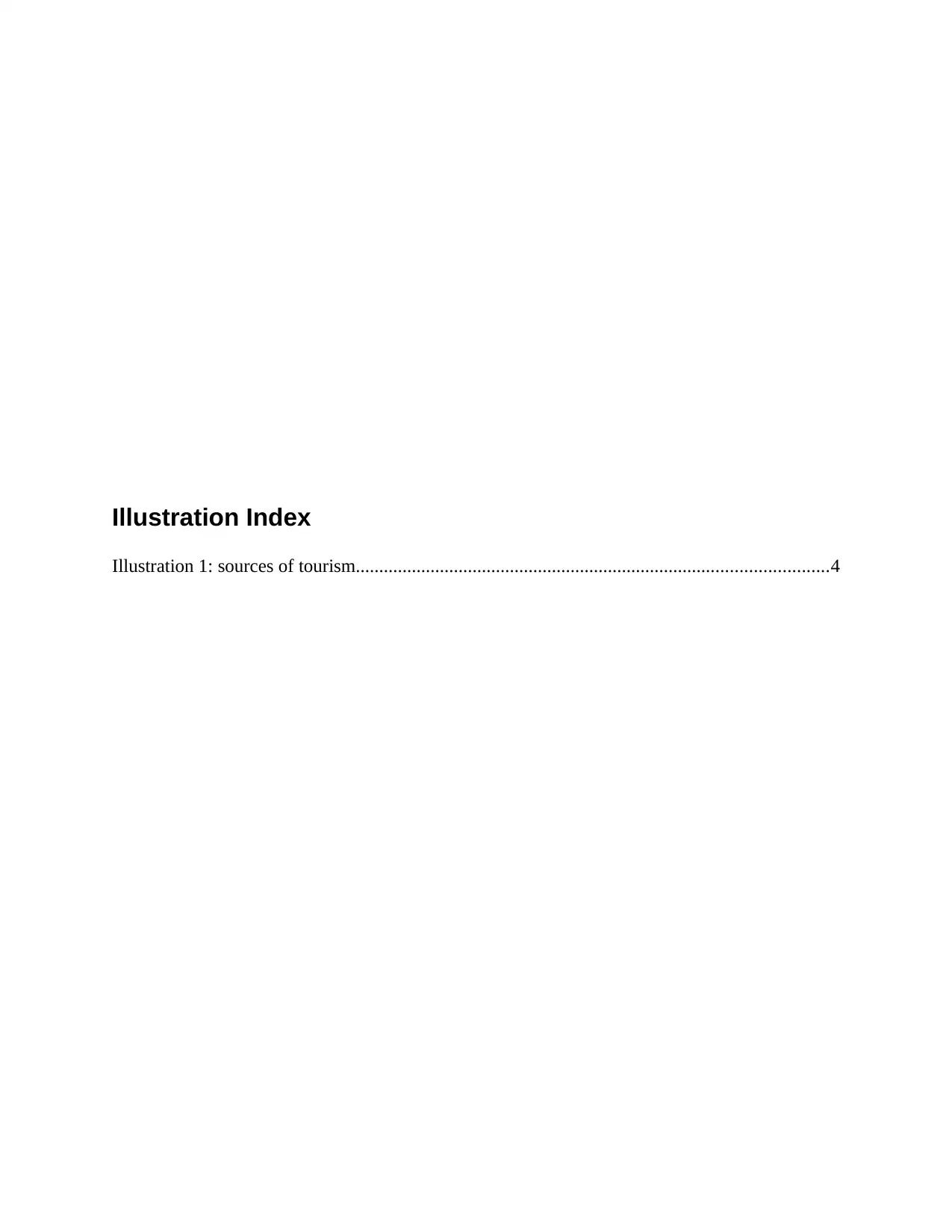
Illustration Index
Illustration 1: sources of tourism.....................................................................................................4
Illustration 1: sources of tourism.....................................................................................................4
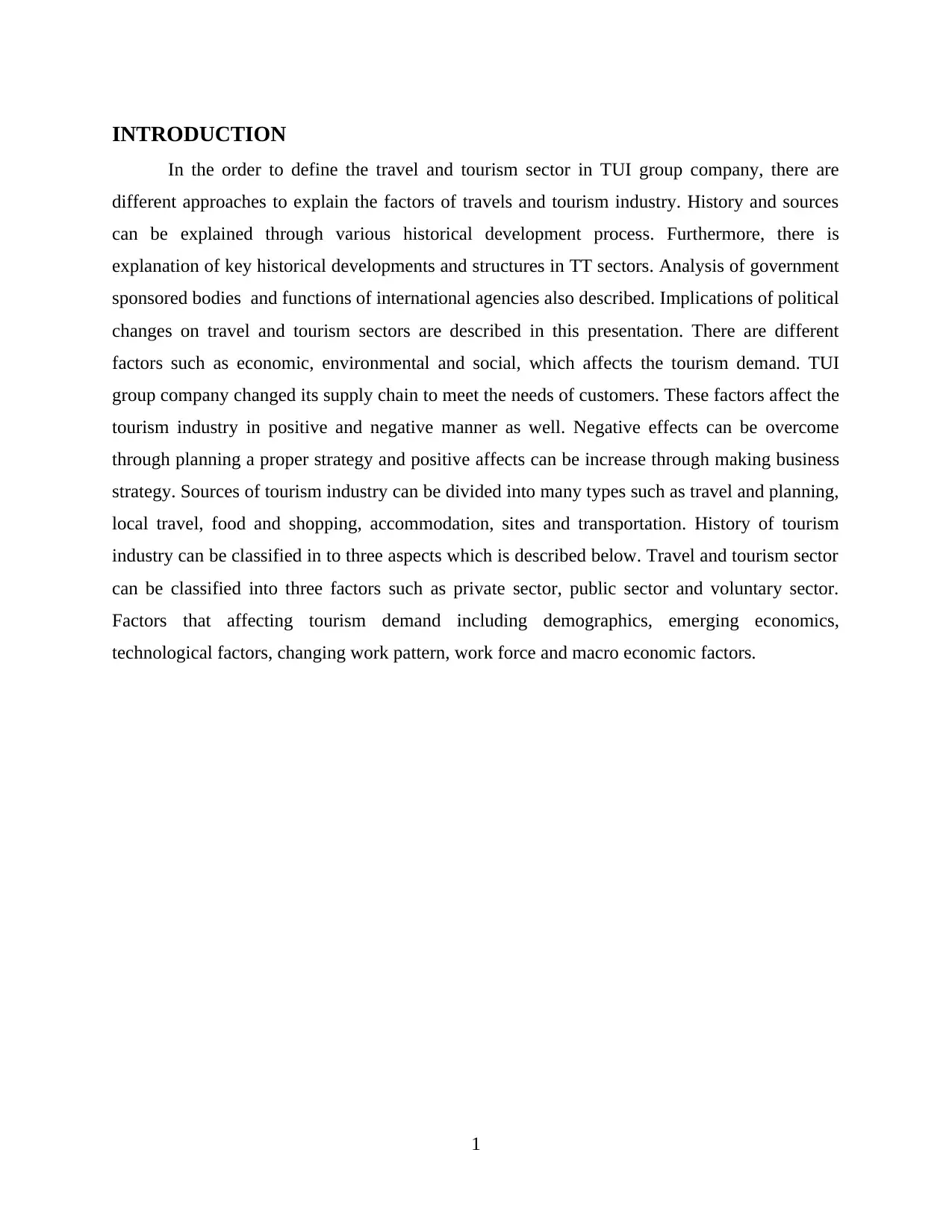
INTRODUCTION
In the order to define the travel and tourism sector in TUI group company, there are
different approaches to explain the factors of travels and tourism industry. History and sources
can be explained through various historical development process. Furthermore, there is
explanation of key historical developments and structures in TT sectors. Analysis of government
sponsored bodies and functions of international agencies also described. Implications of political
changes on travel and tourism sectors are described in this presentation. There are different
factors such as economic, environmental and social, which affects the tourism demand. TUI
group company changed its supply chain to meet the needs of customers. These factors affect the
tourism industry in positive and negative manner as well. Negative effects can be overcome
through planning a proper strategy and positive affects can be increase through making business
strategy. Sources of tourism industry can be divided into many types such as travel and planning,
local travel, food and shopping, accommodation, sites and transportation. History of tourism
industry can be classified in to three aspects which is described below. Travel and tourism sector
can be classified into three factors such as private sector, public sector and voluntary sector.
Factors that affecting tourism demand including demographics, emerging economics,
technological factors, changing work pattern, work force and macro economic factors.
1
In the order to define the travel and tourism sector in TUI group company, there are
different approaches to explain the factors of travels and tourism industry. History and sources
can be explained through various historical development process. Furthermore, there is
explanation of key historical developments and structures in TT sectors. Analysis of government
sponsored bodies and functions of international agencies also described. Implications of political
changes on travel and tourism sectors are described in this presentation. There are different
factors such as economic, environmental and social, which affects the tourism demand. TUI
group company changed its supply chain to meet the needs of customers. These factors affect the
tourism industry in positive and negative manner as well. Negative effects can be overcome
through planning a proper strategy and positive affects can be increase through making business
strategy. Sources of tourism industry can be divided into many types such as travel and planning,
local travel, food and shopping, accommodation, sites and transportation. History of tourism
industry can be classified in to three aspects which is described below. Travel and tourism sector
can be classified into three factors such as private sector, public sector and voluntary sector.
Factors that affecting tourism demand including demographics, emerging economics,
technological factors, changing work pattern, work force and macro economic factors.
1
Secure Best Marks with AI Grader
Need help grading? Try our AI Grader for instant feedback on your assignments.
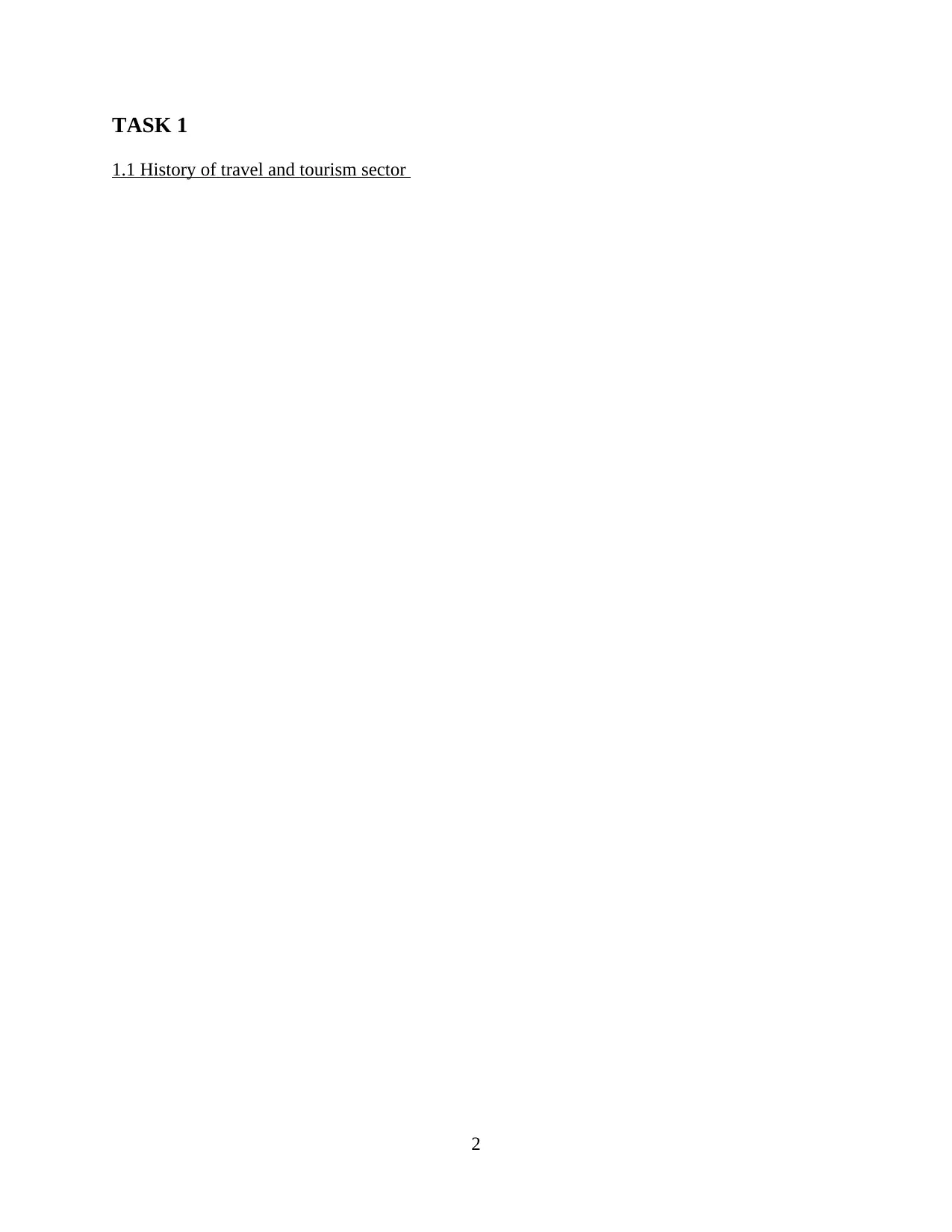
TASK 1
1.1 History of travel and tourism sector
2
1.1 History of travel and tourism sector
2
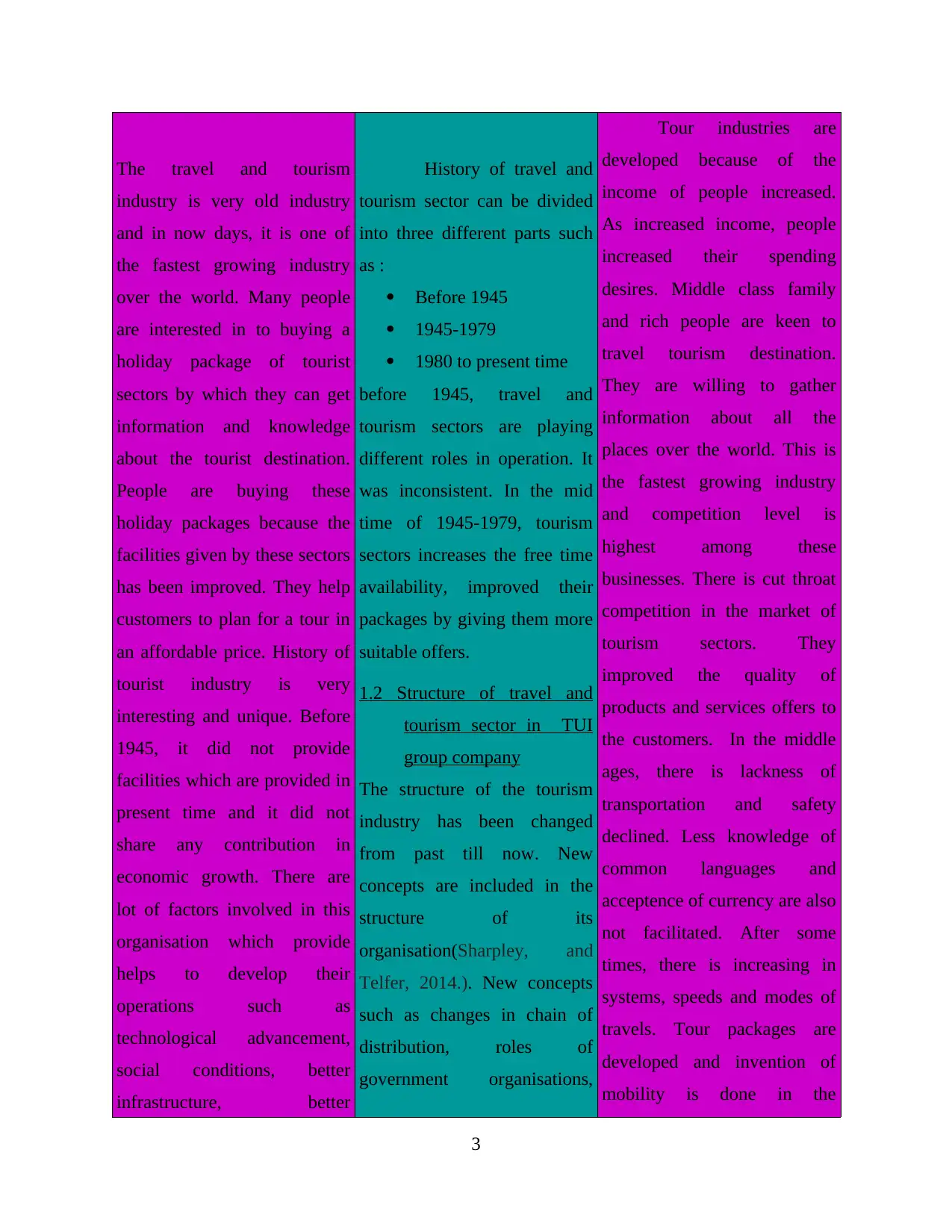
The travel and tourism
industry is very old industry
and in now days, it is one of
the fastest growing industry
over the world. Many people
are interested in to buying a
holiday package of tourist
sectors by which they can get
information and knowledge
about the tourist destination.
People are buying these
holiday packages because the
facilities given by these sectors
has been improved. They help
customers to plan for a tour in
an affordable price. History of
tourist industry is very
interesting and unique. Before
1945, it did not provide
facilities which are provided in
present time and it did not
share any contribution in
economic growth. There are
lot of factors involved in this
organisation which provide
helps to develop their
operations such as
technological advancement,
social conditions, better
infrastructure, better
History of travel and
tourism sector can be divided
into three different parts such
as :
Before 1945
1945-1979
1980 to present time
before 1945, travel and
tourism sectors are playing
different roles in operation. It
was inconsistent. In the mid
time of 1945-1979, tourism
sectors increases the free time
availability, improved their
packages by giving them more
suitable offers.
1.2 Structure of travel and
tourism sector in TUI
group company
The structure of the tourism
industry has been changed
from past till now. New
concepts are included in the
structure of its
organisation(Sharpley, and
Telfer, 2014.). New concepts
such as changes in chain of
distribution, roles of
government organisations,
Tour industries are
developed because of the
income of people increased.
As increased income, people
increased their spending
desires. Middle class family
and rich people are keen to
travel tourism destination.
They are willing to gather
information about all the
places over the world. This is
the fastest growing industry
and competition level is
highest among these
businesses. There is cut throat
competition in the market of
tourism sectors. They
improved the quality of
products and services offers to
the customers. In the middle
ages, there is lackness of
transportation and safety
declined. Less knowledge of
common languages and
acceptence of currency are also
not facilitated. After some
times, there is increasing in
systems, speeds and modes of
travels. Tour packages are
developed and invention of
mobility is done in the
3
industry is very old industry
and in now days, it is one of
the fastest growing industry
over the world. Many people
are interested in to buying a
holiday package of tourist
sectors by which they can get
information and knowledge
about the tourist destination.
People are buying these
holiday packages because the
facilities given by these sectors
has been improved. They help
customers to plan for a tour in
an affordable price. History of
tourist industry is very
interesting and unique. Before
1945, it did not provide
facilities which are provided in
present time and it did not
share any contribution in
economic growth. There are
lot of factors involved in this
organisation which provide
helps to develop their
operations such as
technological advancement,
social conditions, better
infrastructure, better
History of travel and
tourism sector can be divided
into three different parts such
as :
Before 1945
1945-1979
1980 to present time
before 1945, travel and
tourism sectors are playing
different roles in operation. It
was inconsistent. In the mid
time of 1945-1979, tourism
sectors increases the free time
availability, improved their
packages by giving them more
suitable offers.
1.2 Structure of travel and
tourism sector in TUI
group company
The structure of the tourism
industry has been changed
from past till now. New
concepts are included in the
structure of its
organisation(Sharpley, and
Telfer, 2014.). New concepts
such as changes in chain of
distribution, roles of
government organisations,
Tour industries are
developed because of the
income of people increased.
As increased income, people
increased their spending
desires. Middle class family
and rich people are keen to
travel tourism destination.
They are willing to gather
information about all the
places over the world. This is
the fastest growing industry
and competition level is
highest among these
businesses. There is cut throat
competition in the market of
tourism sectors. They
improved the quality of
products and services offers to
the customers. In the middle
ages, there is lackness of
transportation and safety
declined. Less knowledge of
common languages and
acceptence of currency are also
not facilitated. After some
times, there is increasing in
systems, speeds and modes of
travels. Tour packages are
developed and invention of
mobility is done in the
3
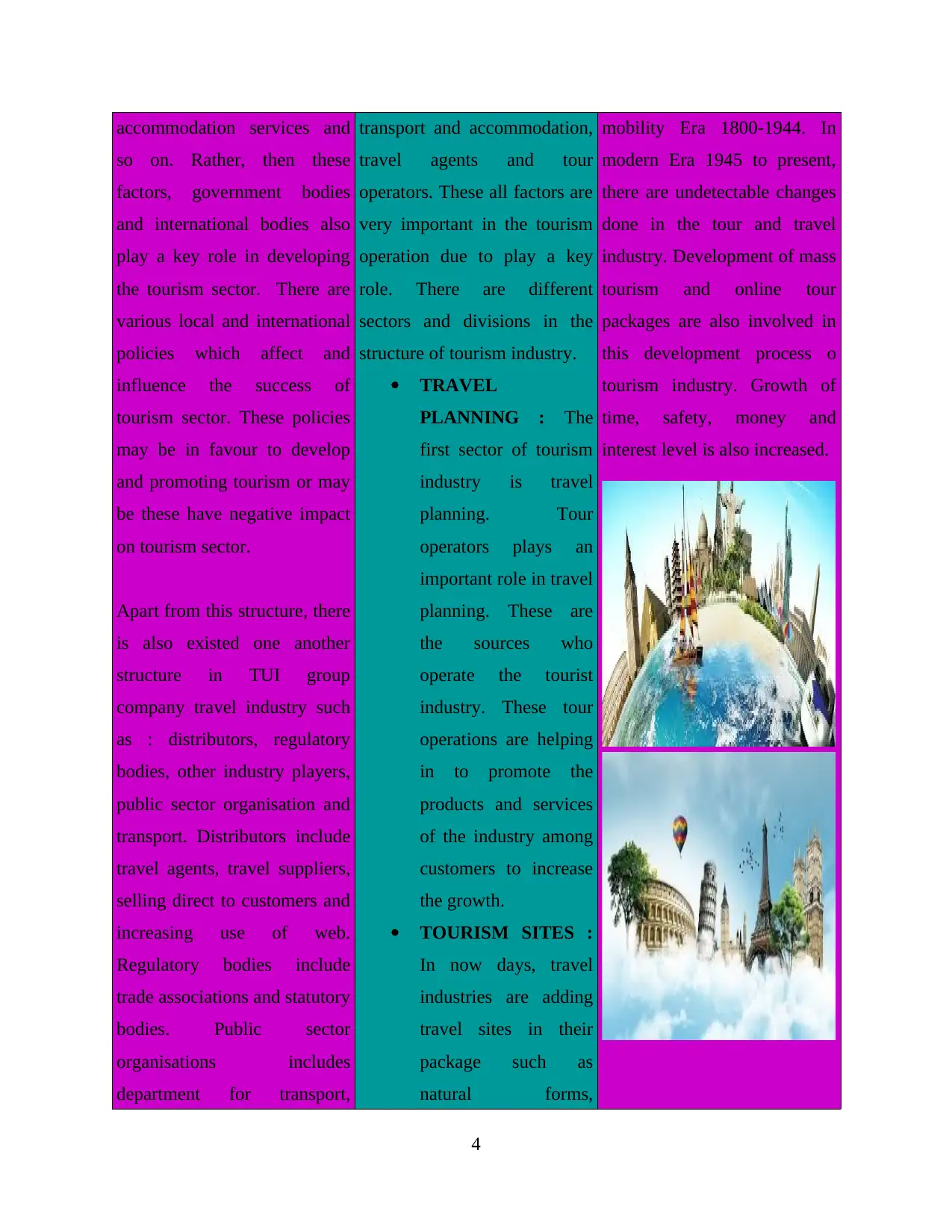
accommodation services and
so on. Rather, then these
factors, government bodies
and international bodies also
play a key role in developing
the tourism sector. There are
various local and international
policies which affect and
influence the success of
tourism sector. These policies
may be in favour to develop
and promoting tourism or may
be these have negative impact
on tourism sector.
Apart from this structure, there
is also existed one another
structure in TUI group
company travel industry such
as : distributors, regulatory
bodies, other industry players,
public sector organisation and
transport. Distributors include
travel agents, travel suppliers,
selling direct to customers and
increasing use of web.
Regulatory bodies include
trade associations and statutory
bodies. Public sector
organisations includes
department for transport,
transport and accommodation,
travel agents and tour
operators. These all factors are
very important in the tourism
operation due to play a key
role. There are different
sectors and divisions in the
structure of tourism industry.
TRAVEL
PLANNING : The
first sector of tourism
industry is travel
planning. Tour
operators plays an
important role in travel
planning. These are
the sources who
operate the tourist
industry. These tour
operations are helping
in to promote the
products and services
of the industry among
customers to increase
the growth.
TOURISM SITES :
In now days, travel
industries are adding
travel sites in their
package such as
natural forms,
mobility Era 1800-1944. In
modern Era 1945 to present,
there are undetectable changes
done in the tour and travel
industry. Development of mass
tourism and online tour
packages are also involved in
this development process o
tourism industry. Growth of
time, safety, money and
interest level is also increased.
4
so on. Rather, then these
factors, government bodies
and international bodies also
play a key role in developing
the tourism sector. There are
various local and international
policies which affect and
influence the success of
tourism sector. These policies
may be in favour to develop
and promoting tourism or may
be these have negative impact
on tourism sector.
Apart from this structure, there
is also existed one another
structure in TUI group
company travel industry such
as : distributors, regulatory
bodies, other industry players,
public sector organisation and
transport. Distributors include
travel agents, travel suppliers,
selling direct to customers and
increasing use of web.
Regulatory bodies include
trade associations and statutory
bodies. Public sector
organisations includes
department for transport,
transport and accommodation,
travel agents and tour
operators. These all factors are
very important in the tourism
operation due to play a key
role. There are different
sectors and divisions in the
structure of tourism industry.
TRAVEL
PLANNING : The
first sector of tourism
industry is travel
planning. Tour
operators plays an
important role in travel
planning. These are
the sources who
operate the tourist
industry. These tour
operations are helping
in to promote the
products and services
of the industry among
customers to increase
the growth.
TOURISM SITES :
In now days, travel
industries are adding
travel sites in their
package such as
natural forms,
mobility Era 1800-1944. In
modern Era 1945 to present,
there are undetectable changes
done in the tour and travel
industry. Development of mass
tourism and online tour
packages are also involved in
this development process o
tourism industry. Growth of
time, safety, money and
interest level is also increased.
4
Paraphrase This Document
Need a fresh take? Get an instant paraphrase of this document with our AI Paraphraser
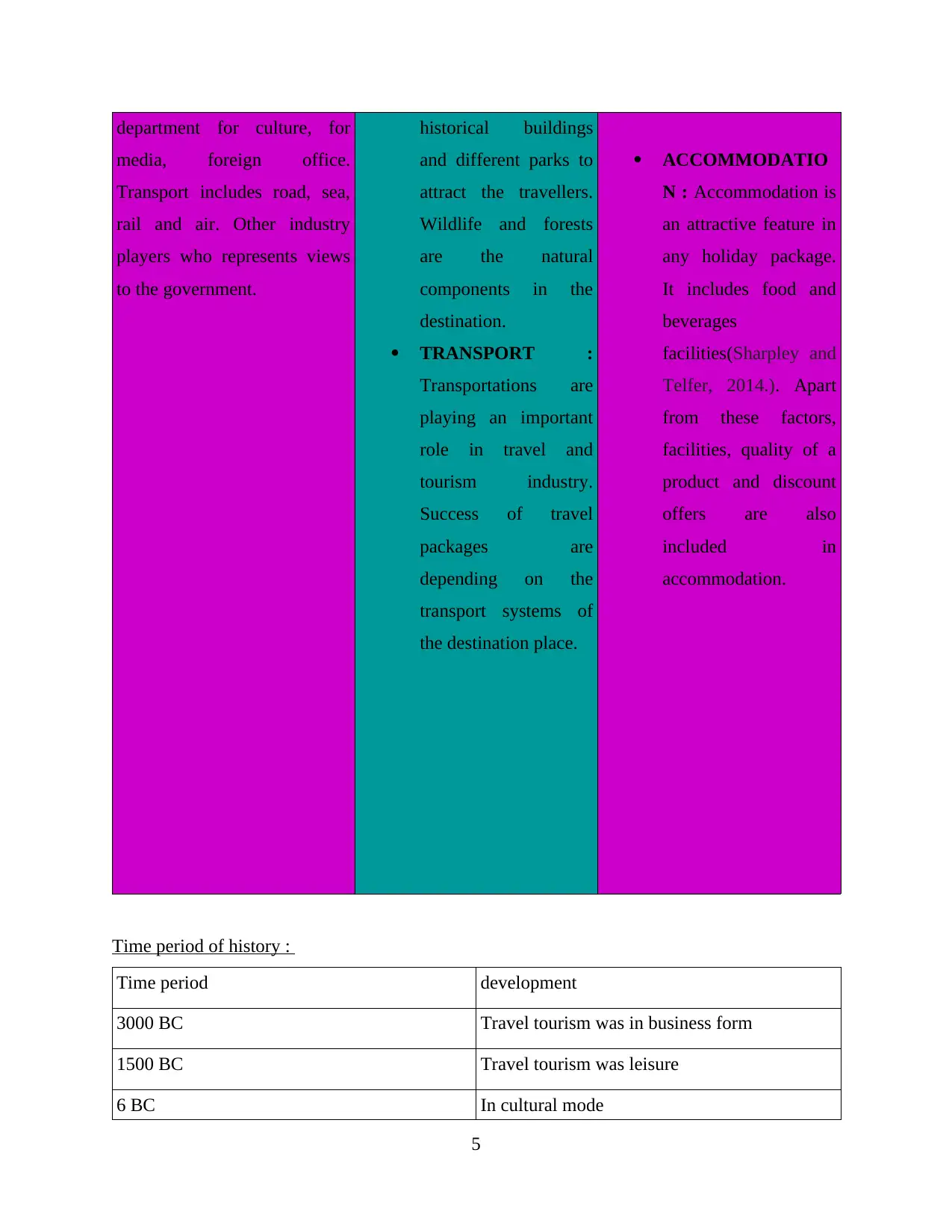
department for culture, for
media, foreign office.
Transport includes road, sea,
rail and air. Other industry
players who represents views
to the government.
historical buildings
and different parks to
attract the travellers.
Wildlife and forests
are the natural
components in the
destination.
TRANSPORT :
Transportations are
playing an important
role in travel and
tourism industry.
Success of travel
packages are
depending on the
transport systems of
the destination place.
ACCOMMODATIO
N : Accommodation is
an attractive feature in
any holiday package.
It includes food and
beverages
facilities(Sharpley and
Telfer, 2014.). Apart
from these factors,
facilities, quality of a
product and discount
offers are also
included in
accommodation.
Time period of history :
Time period development
3000 BC Travel tourism was in business form
1500 BC Travel tourism was leisure
6 BC In cultural mode
5
media, foreign office.
Transport includes road, sea,
rail and air. Other industry
players who represents views
to the government.
historical buildings
and different parks to
attract the travellers.
Wildlife and forests
are the natural
components in the
destination.
TRANSPORT :
Transportations are
playing an important
role in travel and
tourism industry.
Success of travel
packages are
depending on the
transport systems of
the destination place.
ACCOMMODATIO
N : Accommodation is
an attractive feature in
any holiday package.
It includes food and
beverages
facilities(Sharpley and
Telfer, 2014.). Apart
from these factors,
facilities, quality of a
product and discount
offers are also
included in
accommodation.
Time period of history :
Time period development
3000 BC Travel tourism was in business form
1500 BC Travel tourism was leisure
6 BC In cultural mode
5
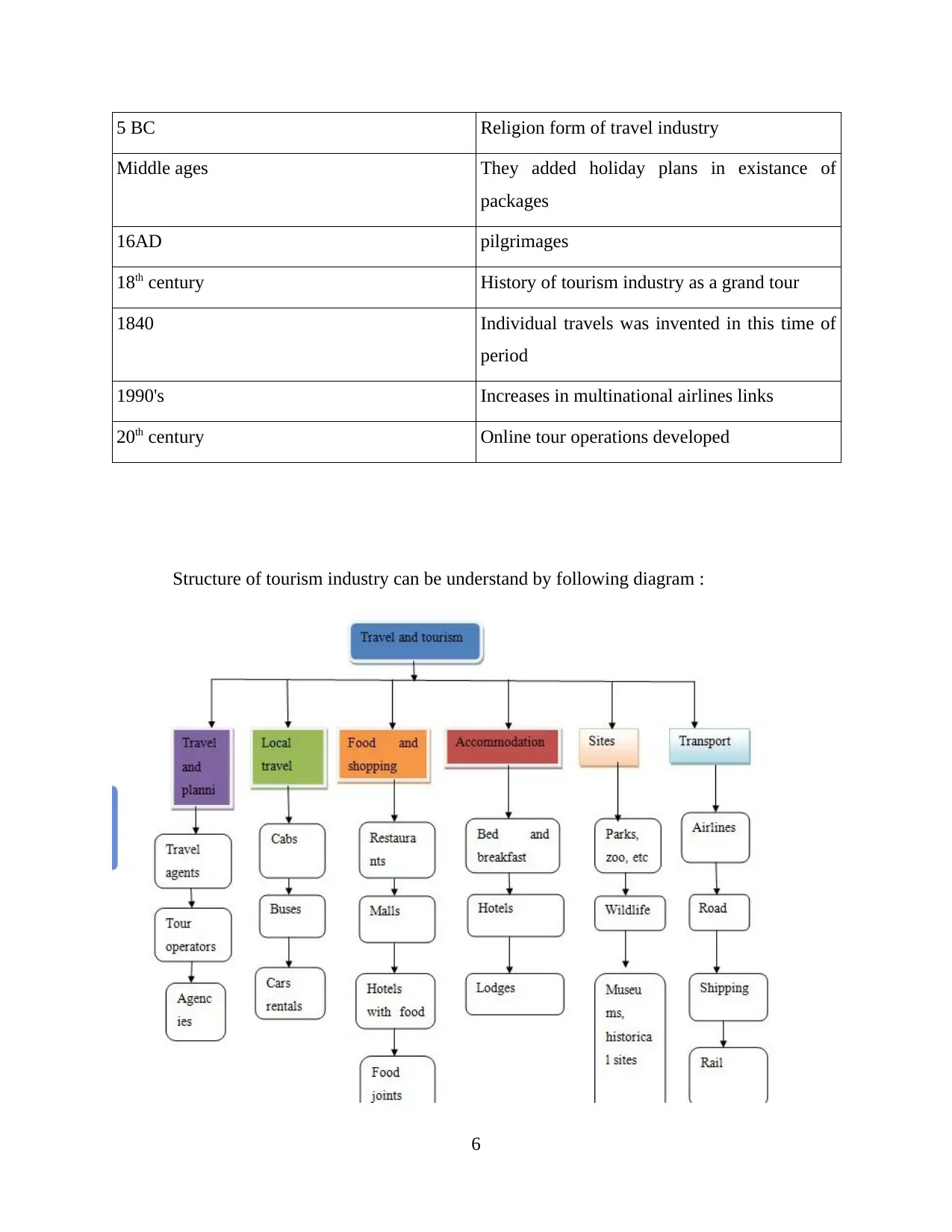
5 BC Religion form of travel industry
Middle ages They added holiday plans in existance of
packages
16AD pilgrimages
18th century History of tourism industry as a grand tour
1840 Individual travels was invented in this time of
period
1990's Increases in multinational airlines links
20th century Online tour operations developed
Structure of tourism industry can be understand by following diagram :
6
Middle ages They added holiday plans in existance of
packages
16AD pilgrimages
18th century History of tourism industry as a grand tour
1840 Individual travels was invented in this time of
period
1990's Increases in multinational airlines links
20th century Online tour operations developed
Structure of tourism industry can be understand by following diagram :
6
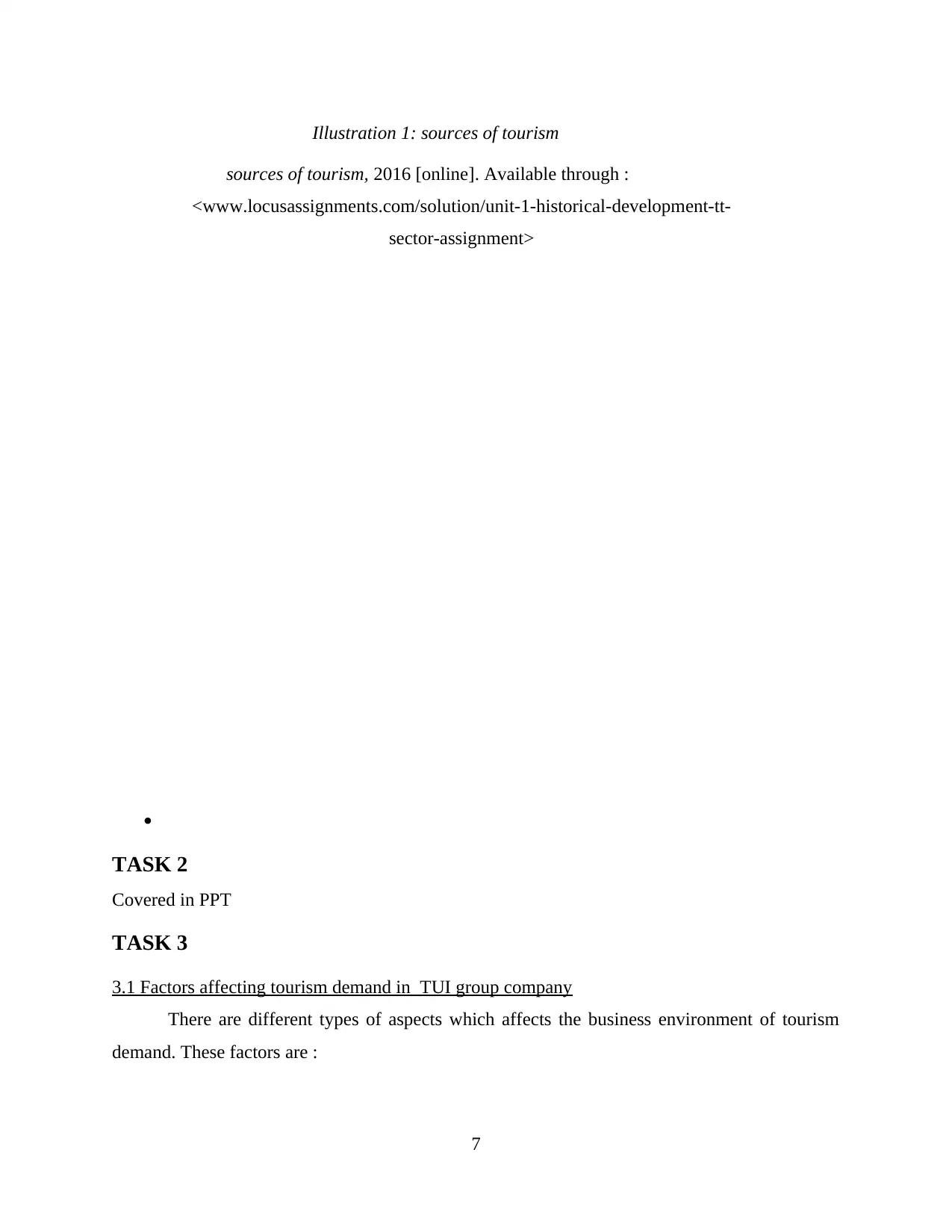
Illustration 1: sources of tourism
sources of tourism, 2016 [online]. Available through :
<www.locusassignments.com/solution/unit-1-historical-development-tt-
sector-assignment>
TASK 2
Covered in PPT
TASK 3
3.1 Factors affecting tourism demand in TUI group company
There are different types of aspects which affects the business environment of tourism
demand. These factors are :
7
sources of tourism, 2016 [online]. Available through :
<www.locusassignments.com/solution/unit-1-historical-development-tt-
sector-assignment>
TASK 2
Covered in PPT
TASK 3
3.1 Factors affecting tourism demand in TUI group company
There are different types of aspects which affects the business environment of tourism
demand. These factors are :
7
Secure Best Marks with AI Grader
Need help grading? Try our AI Grader for instant feedback on your assignments.
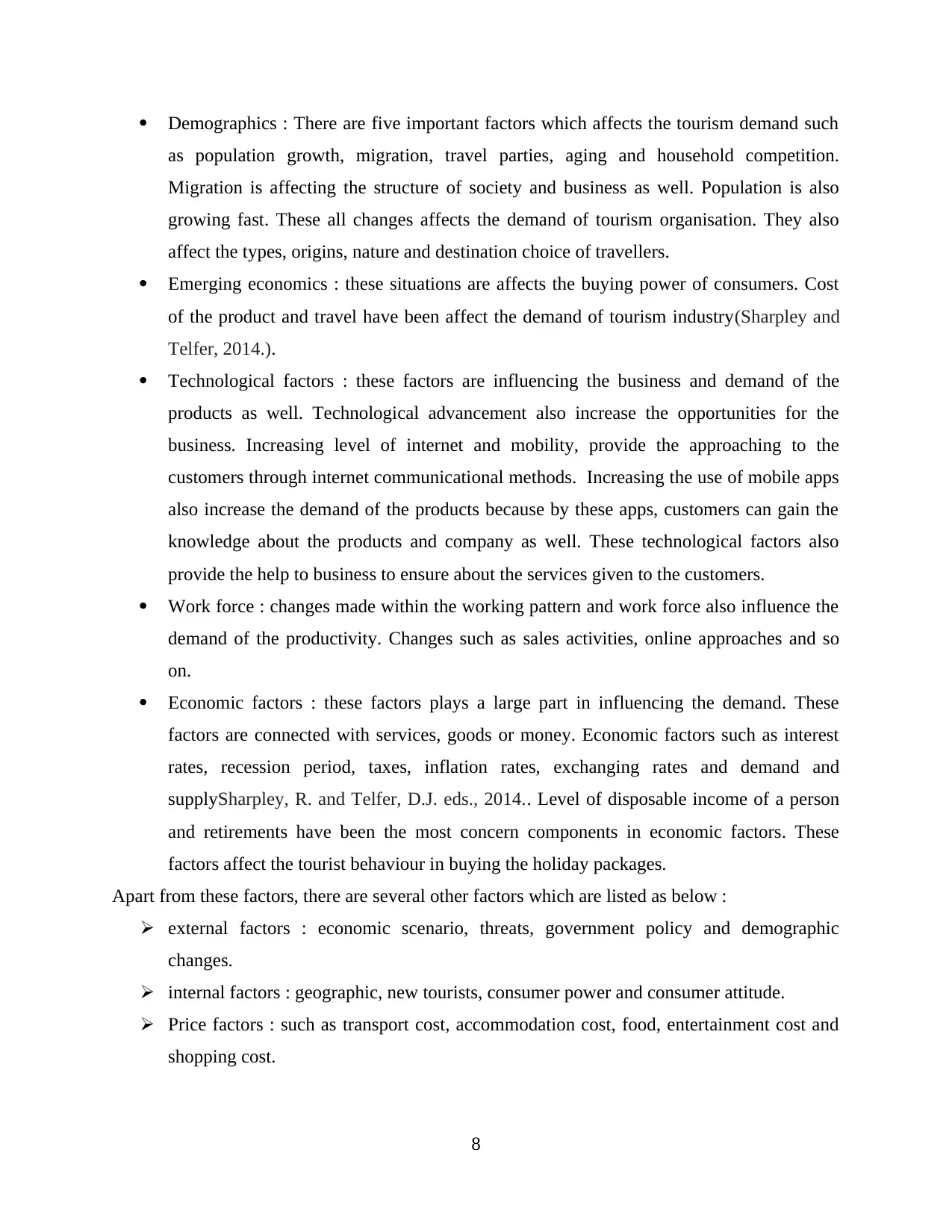
Demographics : There are five important factors which affects the tourism demand such
as population growth, migration, travel parties, aging and household competition.
Migration is affecting the structure of society and business as well. Population is also
growing fast. These all changes affects the demand of tourism organisation. They also
affect the types, origins, nature and destination choice of travellers.
Emerging economics : these situations are affects the buying power of consumers. Cost
of the product and travel have been affect the demand of tourism industry(Sharpley and
Telfer, 2014.).
Technological factors : these factors are influencing the business and demand of the
products as well. Technological advancement also increase the opportunities for the
business. Increasing level of internet and mobility, provide the approaching to the
customers through internet communicational methods. Increasing the use of mobile apps
also increase the demand of the products because by these apps, customers can gain the
knowledge about the products and company as well. These technological factors also
provide the help to business to ensure about the services given to the customers.
Work force : changes made within the working pattern and work force also influence the
demand of the productivity. Changes such as sales activities, online approaches and so
on.
Economic factors : these factors plays a large part in influencing the demand. These
factors are connected with services, goods or money. Economic factors such as interest
rates, recession period, taxes, inflation rates, exchanging rates and demand and
supplySharpley, R. and Telfer, D.J. eds., 2014.. Level of disposable income of a person
and retirements have been the most concern components in economic factors. These
factors affect the tourist behaviour in buying the holiday packages.
Apart from these factors, there are several other factors which are listed as below :
external factors : economic scenario, threats, government policy and demographic
changes.
internal factors : geographic, new tourists, consumer power and consumer attitude.
Price factors : such as transport cost, accommodation cost, food, entertainment cost and
shopping cost.
8
as population growth, migration, travel parties, aging and household competition.
Migration is affecting the structure of society and business as well. Population is also
growing fast. These all changes affects the demand of tourism organisation. They also
affect the types, origins, nature and destination choice of travellers.
Emerging economics : these situations are affects the buying power of consumers. Cost
of the product and travel have been affect the demand of tourism industry(Sharpley and
Telfer, 2014.).
Technological factors : these factors are influencing the business and demand of the
products as well. Technological advancement also increase the opportunities for the
business. Increasing level of internet and mobility, provide the approaching to the
customers through internet communicational methods. Increasing the use of mobile apps
also increase the demand of the products because by these apps, customers can gain the
knowledge about the products and company as well. These technological factors also
provide the help to business to ensure about the services given to the customers.
Work force : changes made within the working pattern and work force also influence the
demand of the productivity. Changes such as sales activities, online approaches and so
on.
Economic factors : these factors plays a large part in influencing the demand. These
factors are connected with services, goods or money. Economic factors such as interest
rates, recession period, taxes, inflation rates, exchanging rates and demand and
supplySharpley, R. and Telfer, D.J. eds., 2014.. Level of disposable income of a person
and retirements have been the most concern components in economic factors. These
factors affect the tourist behaviour in buying the holiday packages.
Apart from these factors, there are several other factors which are listed as below :
external factors : economic scenario, threats, government policy and demographic
changes.
internal factors : geographic, new tourists, consumer power and consumer attitude.
Price factors : such as transport cost, accommodation cost, food, entertainment cost and
shopping cost.
8
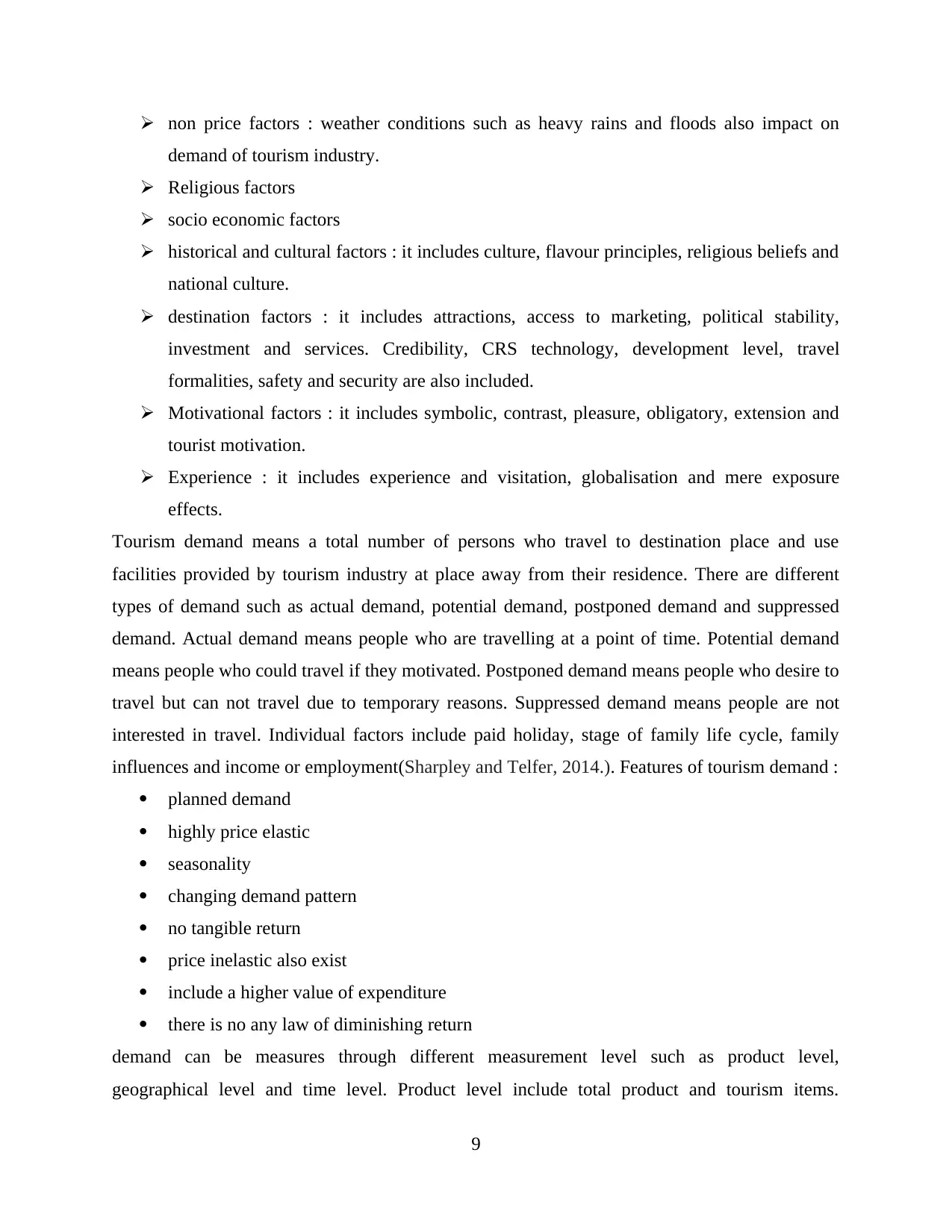
non price factors : weather conditions such as heavy rains and floods also impact on
demand of tourism industry.
Religious factors
socio economic factors
historical and cultural factors : it includes culture, flavour principles, religious beliefs and
national culture.
destination factors : it includes attractions, access to marketing, political stability,
investment and services. Credibility, CRS technology, development level, travel
formalities, safety and security are also included.
Motivational factors : it includes symbolic, contrast, pleasure, obligatory, extension and
tourist motivation.
Experience : it includes experience and visitation, globalisation and mere exposure
effects.
Tourism demand means a total number of persons who travel to destination place and use
facilities provided by tourism industry at place away from their residence. There are different
types of demand such as actual demand, potential demand, postponed demand and suppressed
demand. Actual demand means people who are travelling at a point of time. Potential demand
means people who could travel if they motivated. Postponed demand means people who desire to
travel but can not travel due to temporary reasons. Suppressed demand means people are not
interested in travel. Individual factors include paid holiday, stage of family life cycle, family
influences and income or employment(Sharpley and Telfer, 2014.). Features of tourism demand :
planned demand
highly price elastic
seasonality
changing demand pattern
no tangible return
price inelastic also exist
include a higher value of expenditure
there is no any law of diminishing return
demand can be measures through different measurement level such as product level,
geographical level and time level. Product level include total product and tourism items.
9
demand of tourism industry.
Religious factors
socio economic factors
historical and cultural factors : it includes culture, flavour principles, religious beliefs and
national culture.
destination factors : it includes attractions, access to marketing, political stability,
investment and services. Credibility, CRS technology, development level, travel
formalities, safety and security are also included.
Motivational factors : it includes symbolic, contrast, pleasure, obligatory, extension and
tourist motivation.
Experience : it includes experience and visitation, globalisation and mere exposure
effects.
Tourism demand means a total number of persons who travel to destination place and use
facilities provided by tourism industry at place away from their residence. There are different
types of demand such as actual demand, potential demand, postponed demand and suppressed
demand. Actual demand means people who are travelling at a point of time. Potential demand
means people who could travel if they motivated. Postponed demand means people who desire to
travel but can not travel due to temporary reasons. Suppressed demand means people are not
interested in travel. Individual factors include paid holiday, stage of family life cycle, family
influences and income or employment(Sharpley and Telfer, 2014.). Features of tourism demand :
planned demand
highly price elastic
seasonality
changing demand pattern
no tangible return
price inelastic also exist
include a higher value of expenditure
there is no any law of diminishing return
demand can be measures through different measurement level such as product level,
geographical level and time level. Product level include total product and tourism items.
9
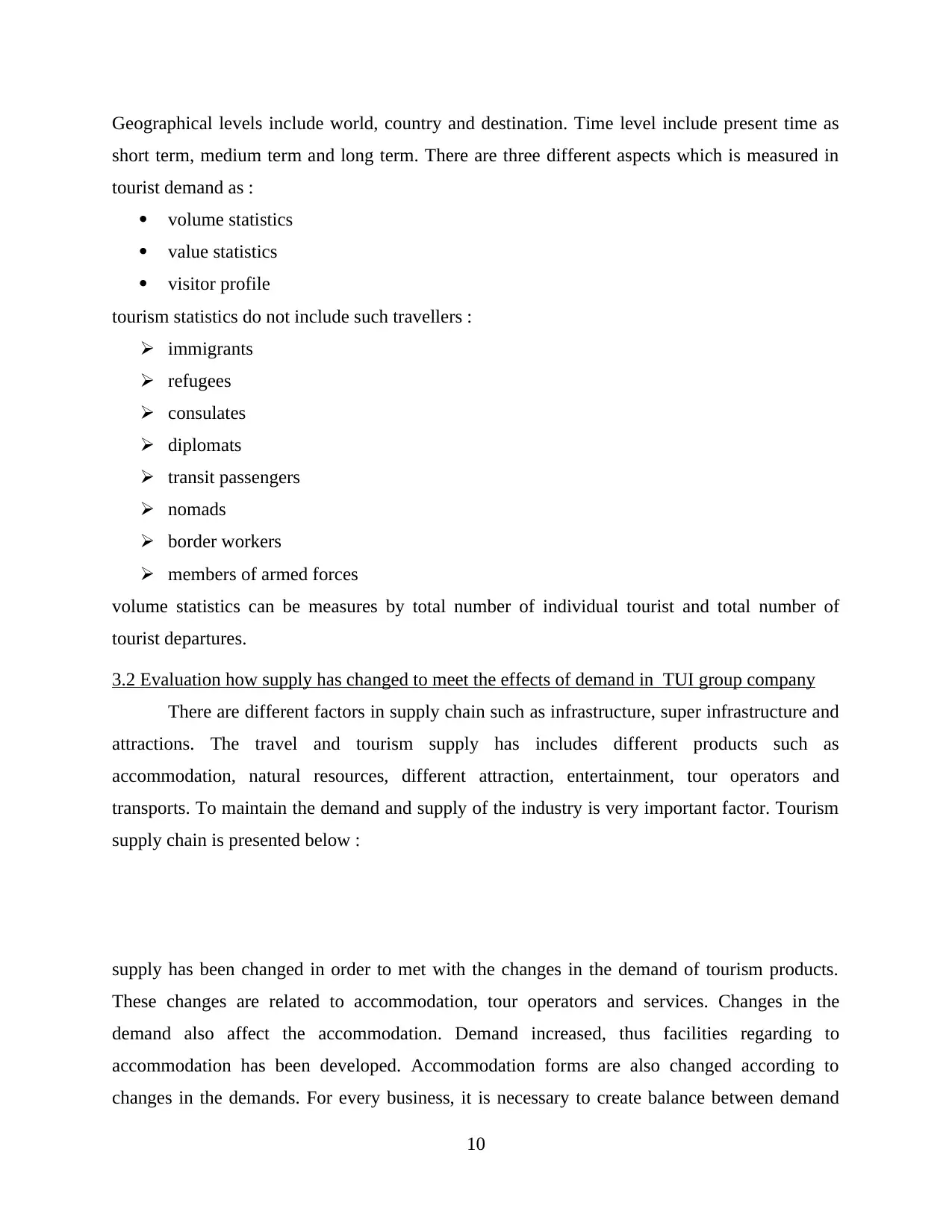
Geographical levels include world, country and destination. Time level include present time as
short term, medium term and long term. There are three different aspects which is measured in
tourist demand as :
volume statistics
value statistics
visitor profile
tourism statistics do not include such travellers :
immigrants
refugees
consulates
diplomats
transit passengers
nomads
border workers
members of armed forces
volume statistics can be measures by total number of individual tourist and total number of
tourist departures.
3.2 Evaluation how supply has changed to meet the effects of demand in TUI group company
There are different factors in supply chain such as infrastructure, super infrastructure and
attractions. The travel and tourism supply has includes different products such as
accommodation, natural resources, different attraction, entertainment, tour operators and
transports. To maintain the demand and supply of the industry is very important factor. Tourism
supply chain is presented below :
supply has been changed in order to met with the changes in the demand of tourism products.
These changes are related to accommodation, tour operators and services. Changes in the
demand also affect the accommodation. Demand increased, thus facilities regarding to
accommodation has been developed. Accommodation forms are also changed according to
changes in the demands. For every business, it is necessary to create balance between demand
10
short term, medium term and long term. There are three different aspects which is measured in
tourist demand as :
volume statistics
value statistics
visitor profile
tourism statistics do not include such travellers :
immigrants
refugees
consulates
diplomats
transit passengers
nomads
border workers
members of armed forces
volume statistics can be measures by total number of individual tourist and total number of
tourist departures.
3.2 Evaluation how supply has changed to meet the effects of demand in TUI group company
There are different factors in supply chain such as infrastructure, super infrastructure and
attractions. The travel and tourism supply has includes different products such as
accommodation, natural resources, different attraction, entertainment, tour operators and
transports. To maintain the demand and supply of the industry is very important factor. Tourism
supply chain is presented below :
supply has been changed in order to met with the changes in the demand of tourism products.
These changes are related to accommodation, tour operators and services. Changes in the
demand also affect the accommodation. Demand increased, thus facilities regarding to
accommodation has been developed. Accommodation forms are also changed according to
changes in the demands. For every business, it is necessary to create balance between demand
10
Paraphrase This Document
Need a fresh take? Get an instant paraphrase of this document with our AI Paraphraser
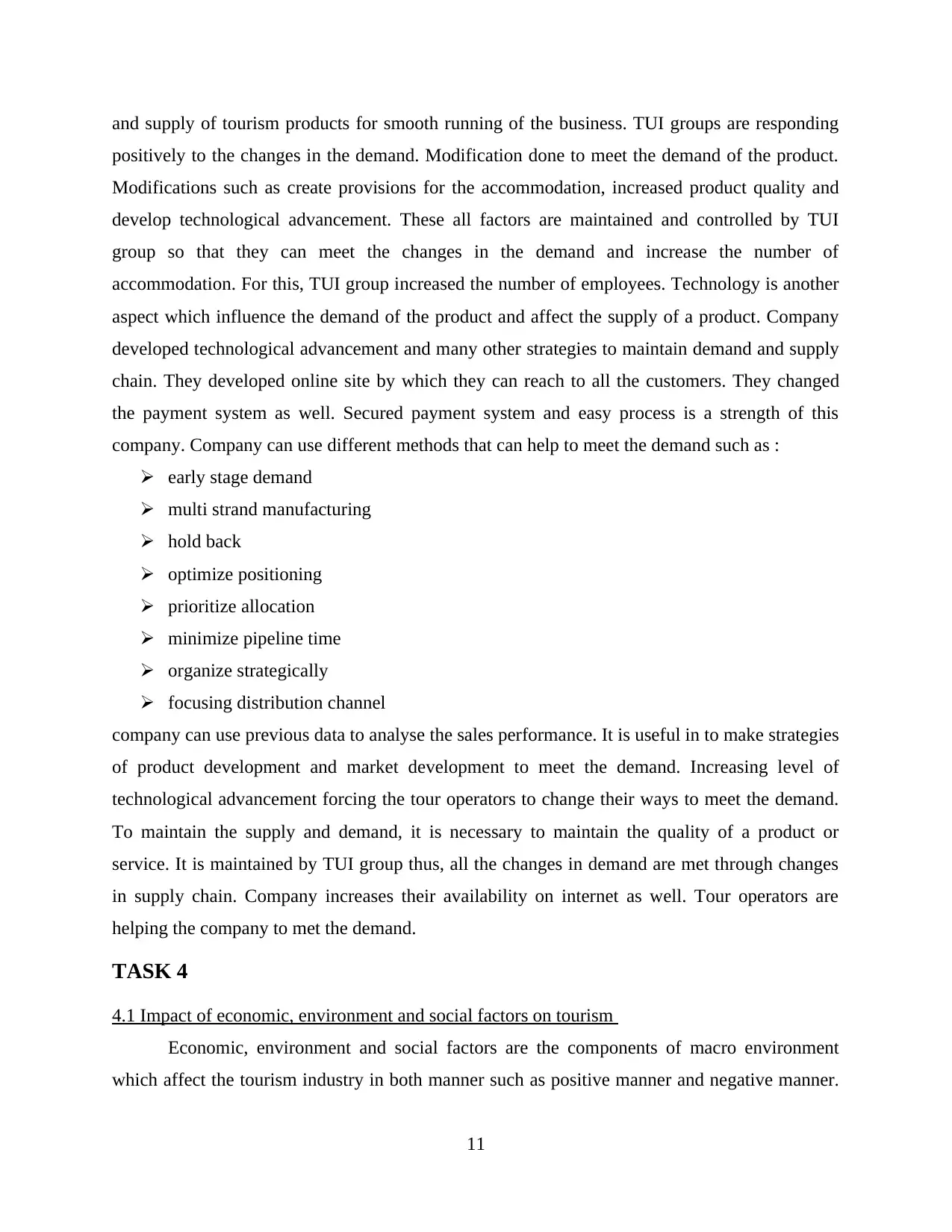
and supply of tourism products for smooth running of the business. TUI groups are responding
positively to the changes in the demand. Modification done to meet the demand of the product.
Modifications such as create provisions for the accommodation, increased product quality and
develop technological advancement. These all factors are maintained and controlled by TUI
group so that they can meet the changes in the demand and increase the number of
accommodation. For this, TUI group increased the number of employees. Technology is another
aspect which influence the demand of the product and affect the supply of a product. Company
developed technological advancement and many other strategies to maintain demand and supply
chain. They developed online site by which they can reach to all the customers. They changed
the payment system as well. Secured payment system and easy process is a strength of this
company. Company can use different methods that can help to meet the demand such as :
early stage demand
multi strand manufacturing
hold back
optimize positioning
prioritize allocation
minimize pipeline time
organize strategically
focusing distribution channel
company can use previous data to analyse the sales performance. It is useful in to make strategies
of product development and market development to meet the demand. Increasing level of
technological advancement forcing the tour operators to change their ways to meet the demand.
To maintain the supply and demand, it is necessary to maintain the quality of a product or
service. It is maintained by TUI group thus, all the changes in demand are met through changes
in supply chain. Company increases their availability on internet as well. Tour operators are
helping the company to met the demand.
TASK 4
4.1 Impact of economic, environment and social factors on tourism
Economic, environment and social factors are the components of macro environment
which affect the tourism industry in both manner such as positive manner and negative manner.
11
positively to the changes in the demand. Modification done to meet the demand of the product.
Modifications such as create provisions for the accommodation, increased product quality and
develop technological advancement. These all factors are maintained and controlled by TUI
group so that they can meet the changes in the demand and increase the number of
accommodation. For this, TUI group increased the number of employees. Technology is another
aspect which influence the demand of the product and affect the supply of a product. Company
developed technological advancement and many other strategies to maintain demand and supply
chain. They developed online site by which they can reach to all the customers. They changed
the payment system as well. Secured payment system and easy process is a strength of this
company. Company can use different methods that can help to meet the demand such as :
early stage demand
multi strand manufacturing
hold back
optimize positioning
prioritize allocation
minimize pipeline time
organize strategically
focusing distribution channel
company can use previous data to analyse the sales performance. It is useful in to make strategies
of product development and market development to meet the demand. Increasing level of
technological advancement forcing the tour operators to change their ways to meet the demand.
To maintain the supply and demand, it is necessary to maintain the quality of a product or
service. It is maintained by TUI group thus, all the changes in demand are met through changes
in supply chain. Company increases their availability on internet as well. Tour operators are
helping the company to met the demand.
TASK 4
4.1 Impact of economic, environment and social factors on tourism
Economic, environment and social factors are the components of macro environment
which affect the tourism industry in both manner such as positive manner and negative manner.
11
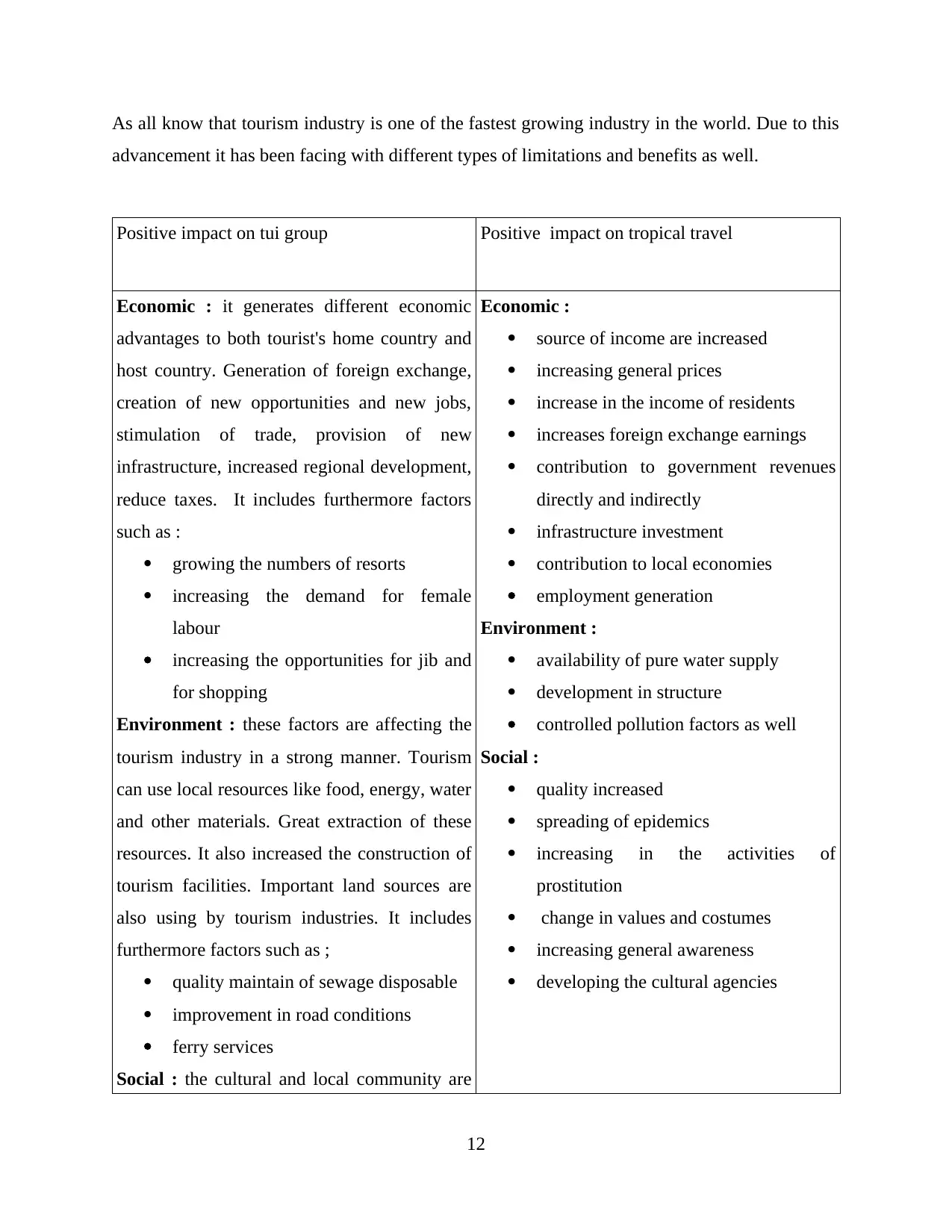
As all know that tourism industry is one of the fastest growing industry in the world. Due to this
advancement it has been facing with different types of limitations and benefits as well.
Positive impact on tui group Positive impact on tropical travel
Economic : it generates different economic
advantages to both tourist's home country and
host country. Generation of foreign exchange,
creation of new opportunities and new jobs,
stimulation of trade, provision of new
infrastructure, increased regional development,
reduce taxes. It includes furthermore factors
such as :
growing the numbers of resorts
increasing the demand for female
labour
increasing the opportunities for jib and
for shopping
Environment : these factors are affecting the
tourism industry in a strong manner. Tourism
can use local resources like food, energy, water
and other materials. Great extraction of these
resources. It also increased the construction of
tourism facilities. Important land sources are
also using by tourism industries. It includes
furthermore factors such as ;
quality maintain of sewage disposable
improvement in road conditions
ferry services
Social : the cultural and local community are
Economic :
source of income are increased
increasing general prices
increase in the income of residents
increases foreign exchange earnings
contribution to government revenues
directly and indirectly
infrastructure investment
contribution to local economies
employment generation
Environment :
availability of pure water supply
development in structure
controlled pollution factors as well
Social :
quality increased
spreading of epidemics
increasing in the activities of
prostitution
change in values and costumes
increasing general awareness
developing the cultural agencies
12
advancement it has been facing with different types of limitations and benefits as well.
Positive impact on tui group Positive impact on tropical travel
Economic : it generates different economic
advantages to both tourist's home country and
host country. Generation of foreign exchange,
creation of new opportunities and new jobs,
stimulation of trade, provision of new
infrastructure, increased regional development,
reduce taxes. It includes furthermore factors
such as :
growing the numbers of resorts
increasing the demand for female
labour
increasing the opportunities for jib and
for shopping
Environment : these factors are affecting the
tourism industry in a strong manner. Tourism
can use local resources like food, energy, water
and other materials. Great extraction of these
resources. It also increased the construction of
tourism facilities. Important land sources are
also using by tourism industries. It includes
furthermore factors such as ;
quality maintain of sewage disposable
improvement in road conditions
ferry services
Social : the cultural and local community are
Economic :
source of income are increased
increasing general prices
increase in the income of residents
increases foreign exchange earnings
contribution to government revenues
directly and indirectly
infrastructure investment
contribution to local economies
employment generation
Environment :
availability of pure water supply
development in structure
controlled pollution factors as well
Social :
quality increased
spreading of epidemics
increasing in the activities of
prostitution
change in values and costumes
increasing general awareness
developing the cultural agencies
12
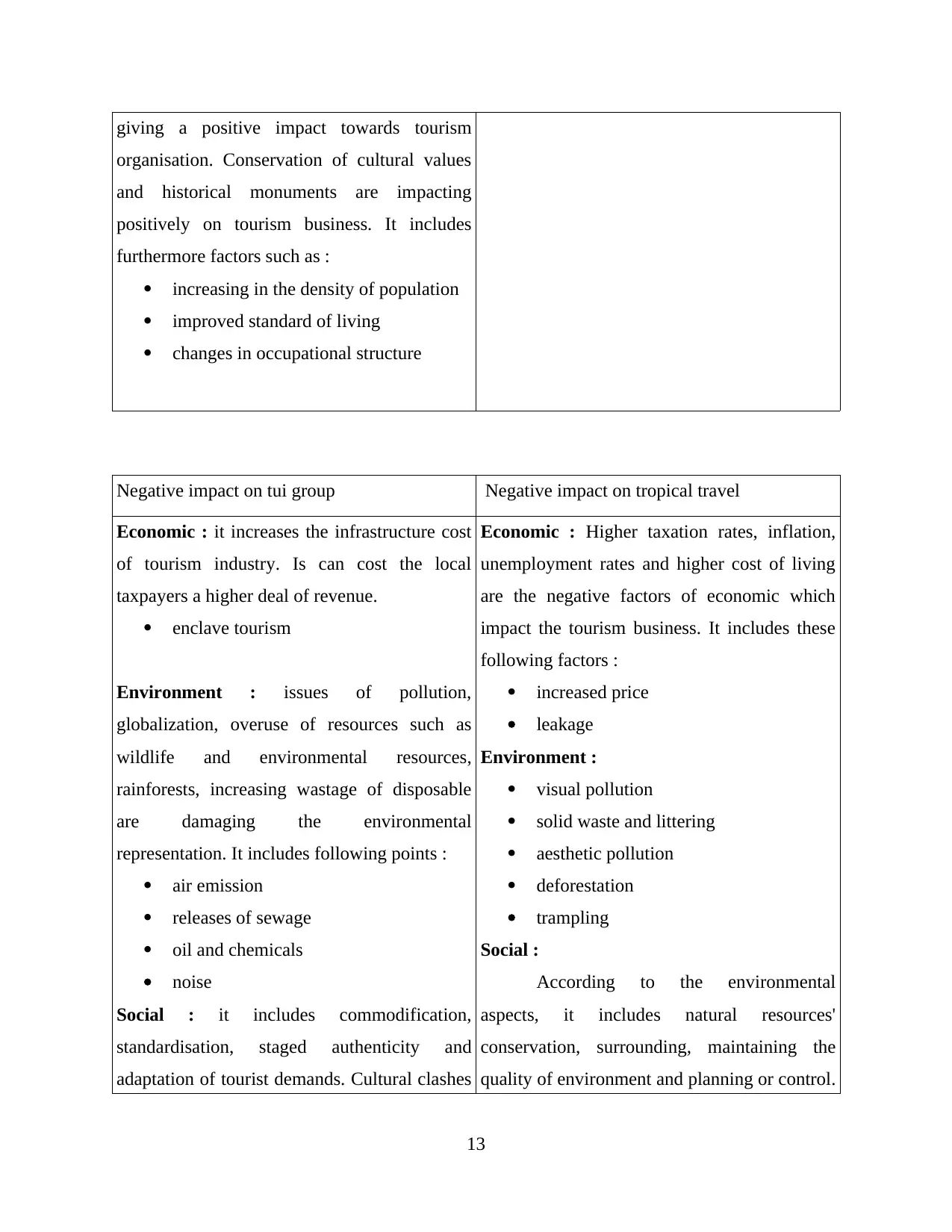
giving a positive impact towards tourism
organisation. Conservation of cultural values
and historical monuments are impacting
positively on tourism business. It includes
furthermore factors such as :
increasing in the density of population
improved standard of living
changes in occupational structure
Negative impact on tui group Negative impact on tropical travel
Economic : it increases the infrastructure cost
of tourism industry. Is can cost the local
taxpayers a higher deal of revenue.
enclave tourism
Environment : issues of pollution,
globalization, overuse of resources such as
wildlife and environmental resources,
rainforests, increasing wastage of disposable
are damaging the environmental
representation. It includes following points :
air emission
releases of sewage
oil and chemicals
noise
Social : it includes commodification,
standardisation, staged authenticity and
adaptation of tourist demands. Cultural clashes
Economic : Higher taxation rates, inflation,
unemployment rates and higher cost of living
are the negative factors of economic which
impact the tourism business. It includes these
following factors :
increased price
leakage
Environment :
visual pollution
solid waste and littering
aesthetic pollution
deforestation
trampling
Social :
According to the environmental
aspects, it includes natural resources'
conservation, surrounding, maintaining the
quality of environment and planning or control.
13
organisation. Conservation of cultural values
and historical monuments are impacting
positively on tourism business. It includes
furthermore factors such as :
increasing in the density of population
improved standard of living
changes in occupational structure
Negative impact on tui group Negative impact on tropical travel
Economic : it increases the infrastructure cost
of tourism industry. Is can cost the local
taxpayers a higher deal of revenue.
enclave tourism
Environment : issues of pollution,
globalization, overuse of resources such as
wildlife and environmental resources,
rainforests, increasing wastage of disposable
are damaging the environmental
representation. It includes following points :
air emission
releases of sewage
oil and chemicals
noise
Social : it includes commodification,
standardisation, staged authenticity and
adaptation of tourist demands. Cultural clashes
Economic : Higher taxation rates, inflation,
unemployment rates and higher cost of living
are the negative factors of economic which
impact the tourism business. It includes these
following factors :
increased price
leakage
Environment :
visual pollution
solid waste and littering
aesthetic pollution
deforestation
trampling
Social :
According to the environmental
aspects, it includes natural resources'
conservation, surrounding, maintaining the
quality of environment and planning or control.
13
Secure Best Marks with AI Grader
Need help grading? Try our AI Grader for instant feedback on your assignments.
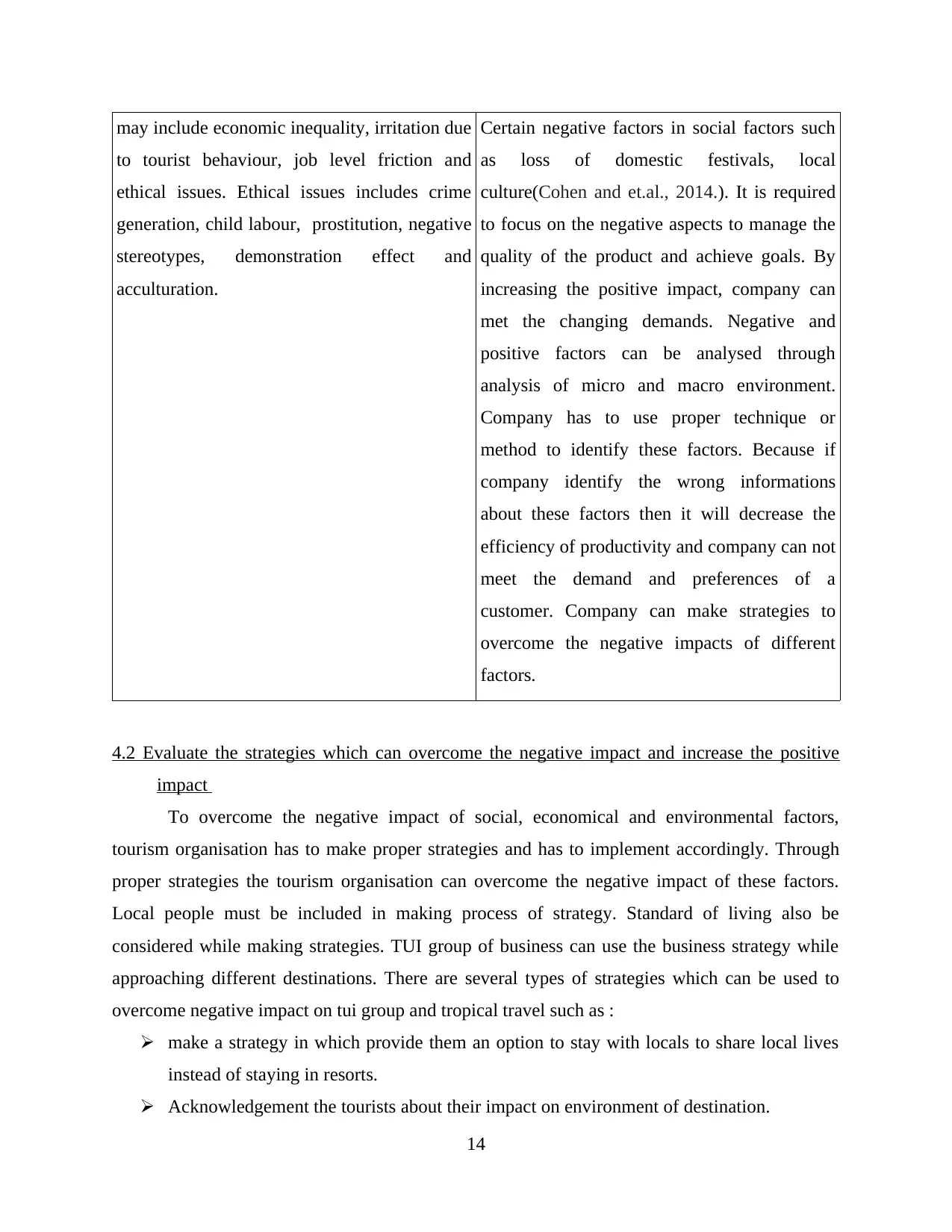
may include economic inequality, irritation due
to tourist behaviour, job level friction and
ethical issues. Ethical issues includes crime
generation, child labour, prostitution, negative
stereotypes, demonstration effect and
acculturation.
Certain negative factors in social factors such
as loss of domestic festivals, local
culture(Cohen and et.al., 2014.). It is required
to focus on the negative aspects to manage the
quality of the product and achieve goals. By
increasing the positive impact, company can
met the changing demands. Negative and
positive factors can be analysed through
analysis of micro and macro environment.
Company has to use proper technique or
method to identify these factors. Because if
company identify the wrong informations
about these factors then it will decrease the
efficiency of productivity and company can not
meet the demand and preferences of a
customer. Company can make strategies to
overcome the negative impacts of different
factors.
4.2 Evaluate the strategies which can overcome the negative impact and increase the positive
impact
To overcome the negative impact of social, economical and environmental factors,
tourism organisation has to make proper strategies and has to implement accordingly. Through
proper strategies the tourism organisation can overcome the negative impact of these factors.
Local people must be included in making process of strategy. Standard of living also be
considered while making strategies. TUI group of business can use the business strategy while
approaching different destinations. There are several types of strategies which can be used to
overcome negative impact on tui group and tropical travel such as :
make a strategy in which provide them an option to stay with locals to share local lives
instead of staying in resorts.
Acknowledgement the tourists about their impact on environment of destination.
14
to tourist behaviour, job level friction and
ethical issues. Ethical issues includes crime
generation, child labour, prostitution, negative
stereotypes, demonstration effect and
acculturation.
Certain negative factors in social factors such
as loss of domestic festivals, local
culture(Cohen and et.al., 2014.). It is required
to focus on the negative aspects to manage the
quality of the product and achieve goals. By
increasing the positive impact, company can
met the changing demands. Negative and
positive factors can be analysed through
analysis of micro and macro environment.
Company has to use proper technique or
method to identify these factors. Because if
company identify the wrong informations
about these factors then it will decrease the
efficiency of productivity and company can not
meet the demand and preferences of a
customer. Company can make strategies to
overcome the negative impacts of different
factors.
4.2 Evaluate the strategies which can overcome the negative impact and increase the positive
impact
To overcome the negative impact of social, economical and environmental factors,
tourism organisation has to make proper strategies and has to implement accordingly. Through
proper strategies the tourism organisation can overcome the negative impact of these factors.
Local people must be included in making process of strategy. Standard of living also be
considered while making strategies. TUI group of business can use the business strategy while
approaching different destinations. There are several types of strategies which can be used to
overcome negative impact on tui group and tropical travel such as :
make a strategy in which provide them an option to stay with locals to share local lives
instead of staying in resorts.
Acknowledgement the tourists about their impact on environment of destination.
14
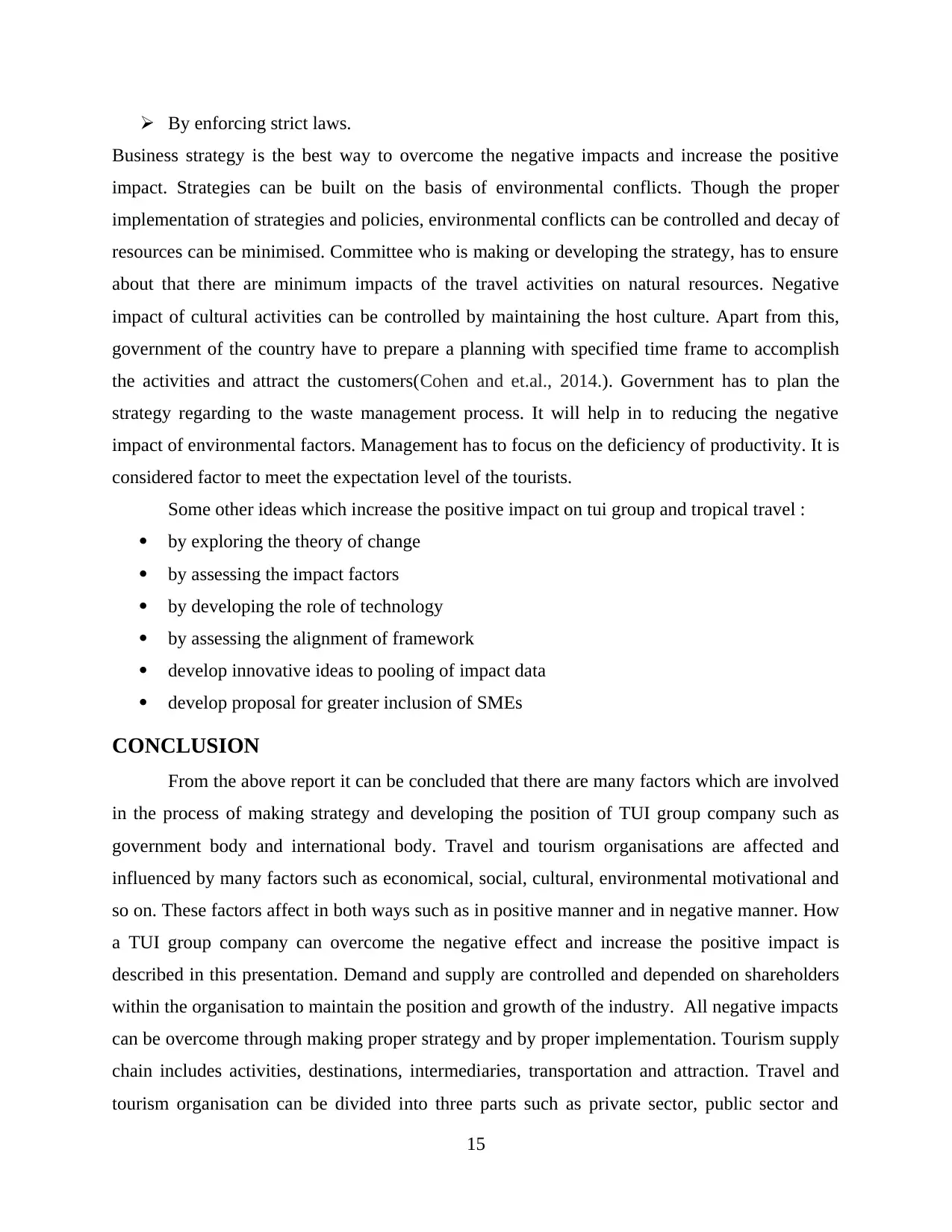
By enforcing strict laws.
Business strategy is the best way to overcome the negative impacts and increase the positive
impact. Strategies can be built on the basis of environmental conflicts. Though the proper
implementation of strategies and policies, environmental conflicts can be controlled and decay of
resources can be minimised. Committee who is making or developing the strategy, has to ensure
about that there are minimum impacts of the travel activities on natural resources. Negative
impact of cultural activities can be controlled by maintaining the host culture. Apart from this,
government of the country have to prepare a planning with specified time frame to accomplish
the activities and attract the customers(Cohen and et.al., 2014.). Government has to plan the
strategy regarding to the waste management process. It will help in to reducing the negative
impact of environmental factors. Management has to focus on the deficiency of productivity. It is
considered factor to meet the expectation level of the tourists.
Some other ideas which increase the positive impact on tui group and tropical travel :
by exploring the theory of change
by assessing the impact factors
by developing the role of technology
by assessing the alignment of framework
develop innovative ideas to pooling of impact data
develop proposal for greater inclusion of SMEs
CONCLUSION
From the above report it can be concluded that there are many factors which are involved
in the process of making strategy and developing the position of TUI group company such as
government body and international body. Travel and tourism organisations are affected and
influenced by many factors such as economical, social, cultural, environmental motivational and
so on. These factors affect in both ways such as in positive manner and in negative manner. How
a TUI group company can overcome the negative effect and increase the positive impact is
described in this presentation. Demand and supply are controlled and depended on shareholders
within the organisation to maintain the position and growth of the industry. All negative impacts
can be overcome through making proper strategy and by proper implementation. Tourism supply
chain includes activities, destinations, intermediaries, transportation and attraction. Travel and
tourism organisation can be divided into three parts such as private sector, public sector and
15
Business strategy is the best way to overcome the negative impacts and increase the positive
impact. Strategies can be built on the basis of environmental conflicts. Though the proper
implementation of strategies and policies, environmental conflicts can be controlled and decay of
resources can be minimised. Committee who is making or developing the strategy, has to ensure
about that there are minimum impacts of the travel activities on natural resources. Negative
impact of cultural activities can be controlled by maintaining the host culture. Apart from this,
government of the country have to prepare a planning with specified time frame to accomplish
the activities and attract the customers(Cohen and et.al., 2014.). Government has to plan the
strategy regarding to the waste management process. It will help in to reducing the negative
impact of environmental factors. Management has to focus on the deficiency of productivity. It is
considered factor to meet the expectation level of the tourists.
Some other ideas which increase the positive impact on tui group and tropical travel :
by exploring the theory of change
by assessing the impact factors
by developing the role of technology
by assessing the alignment of framework
develop innovative ideas to pooling of impact data
develop proposal for greater inclusion of SMEs
CONCLUSION
From the above report it can be concluded that there are many factors which are involved
in the process of making strategy and developing the position of TUI group company such as
government body and international body. Travel and tourism organisations are affected and
influenced by many factors such as economical, social, cultural, environmental motivational and
so on. These factors affect in both ways such as in positive manner and in negative manner. How
a TUI group company can overcome the negative effect and increase the positive impact is
described in this presentation. Demand and supply are controlled and depended on shareholders
within the organisation to maintain the position and growth of the industry. All negative impacts
can be overcome through making proper strategy and by proper implementation. Tourism supply
chain includes activities, destinations, intermediaries, transportation and attraction. Travel and
tourism organisation can be divided into three parts such as private sector, public sector and
15
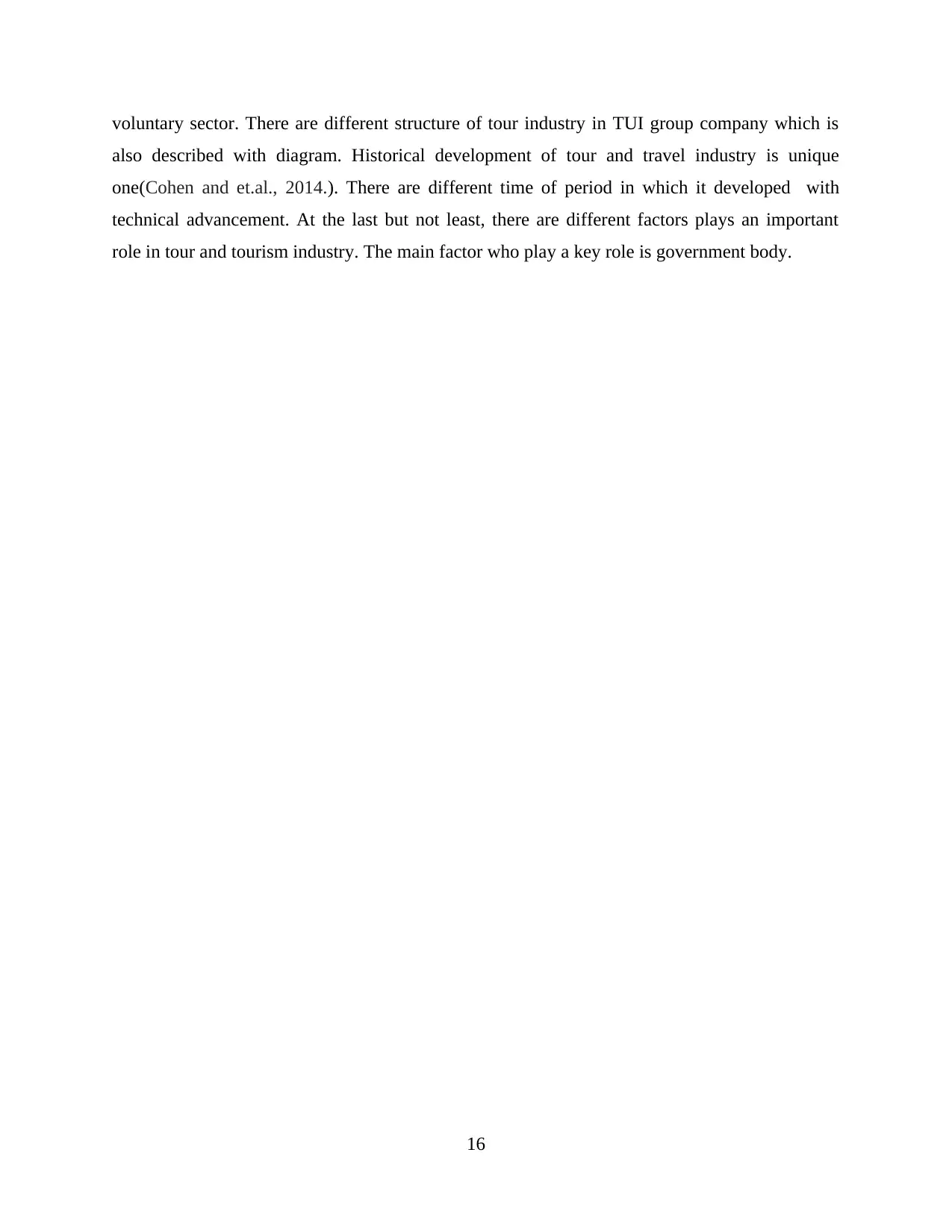
voluntary sector. There are different structure of tour industry in TUI group company which is
also described with diagram. Historical development of tour and travel industry is unique
one(Cohen and et.al., 2014.). There are different time of period in which it developed with
technical advancement. At the last but not least, there are different factors plays an important
role in tour and tourism industry. The main factor who play a key role is government body.
16
also described with diagram. Historical development of tour and travel industry is unique
one(Cohen and et.al., 2014.). There are different time of period in which it developed with
technical advancement. At the last but not least, there are different factors plays an important
role in tour and tourism industry. The main factor who play a key role is government body.
16
Paraphrase This Document
Need a fresh take? Get an instant paraphrase of this document with our AI Paraphraser
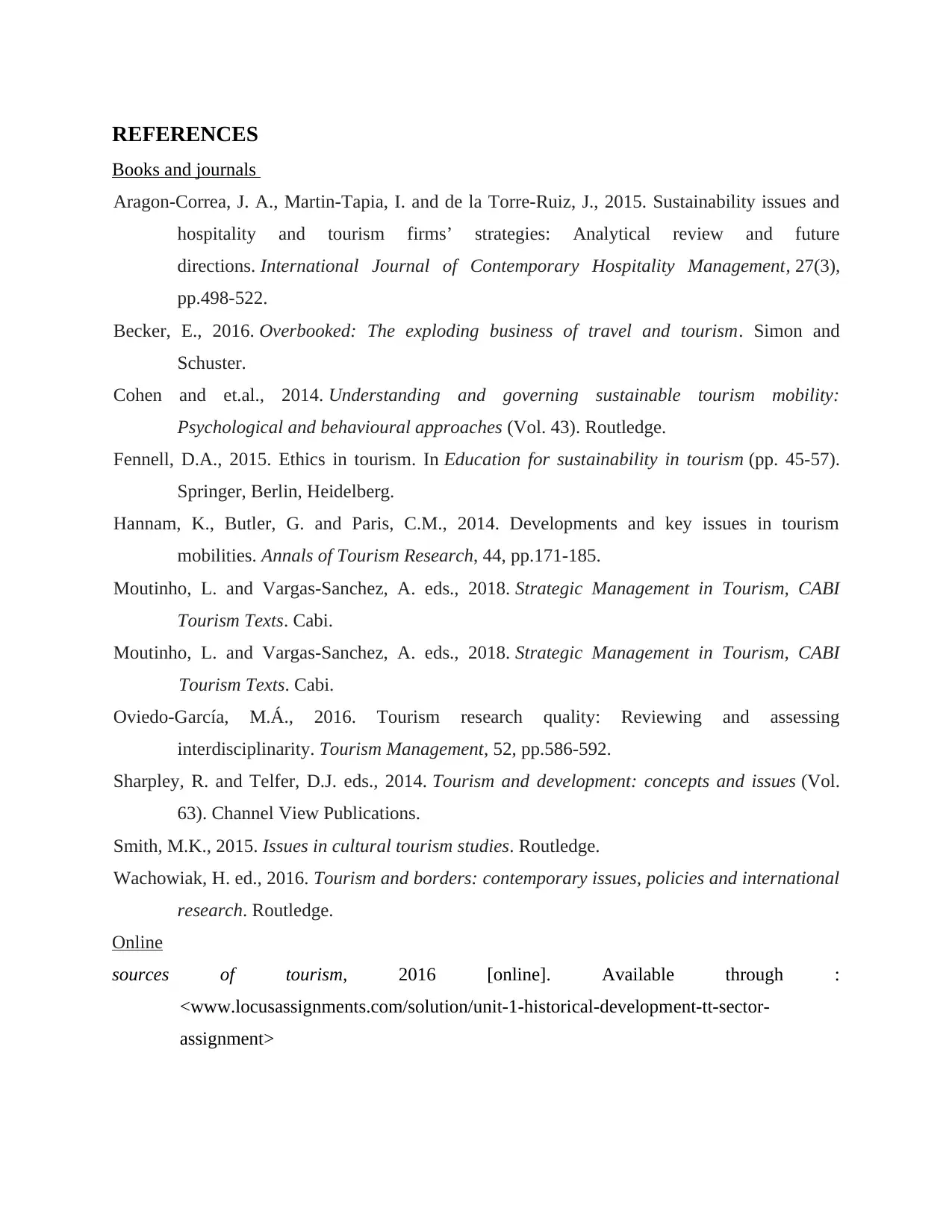
REFERENCES
Books and journals
Aragon-Correa, J. A., Martin-Tapia, I. and de la Torre-Ruiz, J., 2015. Sustainability issues and
hospitality and tourism firms’ strategies: Analytical review and future
directions. International Journal of Contemporary Hospitality Management, 27(3),
pp.498-522.
Becker, E., 2016. Overbooked: The exploding business of travel and tourism. Simon and
Schuster.
Cohen and et.al., 2014. Understanding and governing sustainable tourism mobility:
Psychological and behavioural approaches (Vol. 43). Routledge.
Fennell, D.A., 2015. Ethics in tourism. In Education for sustainability in tourism (pp. 45-57).
Springer, Berlin, Heidelberg.
Hannam, K., Butler, G. and Paris, C.M., 2014. Developments and key issues in tourism
mobilities. Annals of Tourism Research, 44, pp.171-185.
Moutinho, L. and Vargas-Sanchez, A. eds., 2018. Strategic Management in Tourism, CABI
Tourism Texts. Cabi.
Moutinho, L. and Vargas-Sanchez, A. eds., 2018. Strategic Management in Tourism, CABI
Tourism Texts. Cabi.
Oviedo-García, M.Á., 2016. Tourism research quality: Reviewing and assessing
interdisciplinarity. Tourism Management, 52, pp.586-592.
Sharpley, R. and Telfer, D.J. eds., 2014. Tourism and development: concepts and issues (Vol.
63). Channel View Publications.
Smith, M.K., 2015. Issues in cultural tourism studies. Routledge.
Wachowiak, H. ed., 2016. Tourism and borders: contemporary issues, policies and international
research. Routledge.
Online
sources of tourism, 2016 [online]. Available through :
<www.locusassignments.com/solution/unit-1-historical-development-tt-sector-
assignment>
Books and journals
Aragon-Correa, J. A., Martin-Tapia, I. and de la Torre-Ruiz, J., 2015. Sustainability issues and
hospitality and tourism firms’ strategies: Analytical review and future
directions. International Journal of Contemporary Hospitality Management, 27(3),
pp.498-522.
Becker, E., 2016. Overbooked: The exploding business of travel and tourism. Simon and
Schuster.
Cohen and et.al., 2014. Understanding and governing sustainable tourism mobility:
Psychological and behavioural approaches (Vol. 43). Routledge.
Fennell, D.A., 2015. Ethics in tourism. In Education for sustainability in tourism (pp. 45-57).
Springer, Berlin, Heidelberg.
Hannam, K., Butler, G. and Paris, C.M., 2014. Developments and key issues in tourism
mobilities. Annals of Tourism Research, 44, pp.171-185.
Moutinho, L. and Vargas-Sanchez, A. eds., 2018. Strategic Management in Tourism, CABI
Tourism Texts. Cabi.
Moutinho, L. and Vargas-Sanchez, A. eds., 2018. Strategic Management in Tourism, CABI
Tourism Texts. Cabi.
Oviedo-García, M.Á., 2016. Tourism research quality: Reviewing and assessing
interdisciplinarity. Tourism Management, 52, pp.586-592.
Sharpley, R. and Telfer, D.J. eds., 2014. Tourism and development: concepts and issues (Vol.
63). Channel View Publications.
Smith, M.K., 2015. Issues in cultural tourism studies. Routledge.
Wachowiak, H. ed., 2016. Tourism and borders: contemporary issues, policies and international
research. Routledge.
Online
sources of tourism, 2016 [online]. Available through :
<www.locusassignments.com/solution/unit-1-historical-development-tt-sector-
assignment>
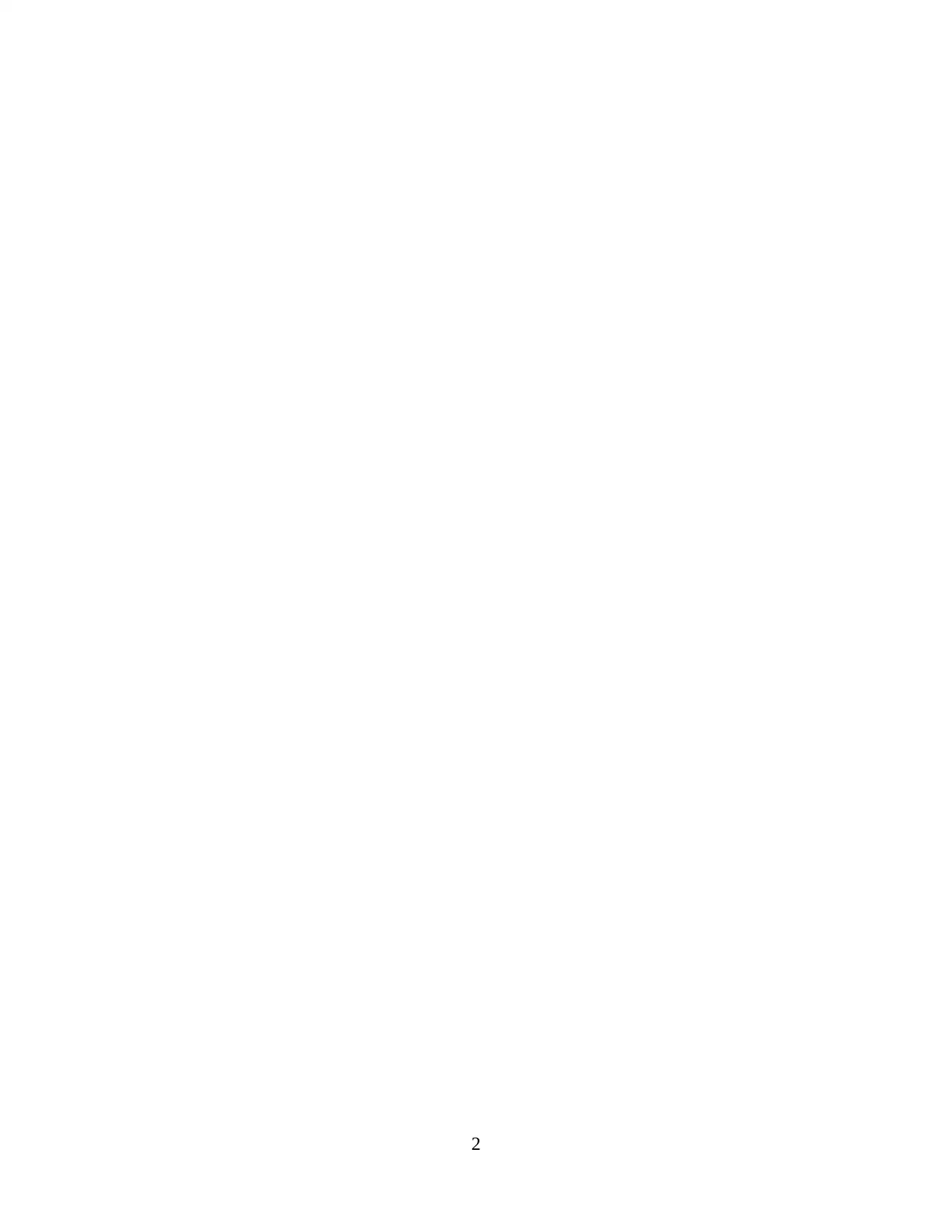
2
1 out of 21
Related Documents
Your All-in-One AI-Powered Toolkit for Academic Success.
+13062052269
info@desklib.com
Available 24*7 on WhatsApp / Email
![[object Object]](/_next/static/media/star-bottom.7253800d.svg)
Unlock your academic potential
© 2024 | Zucol Services PVT LTD | All rights reserved.





